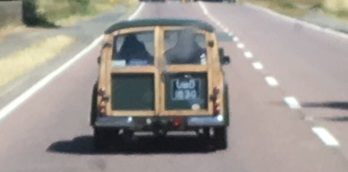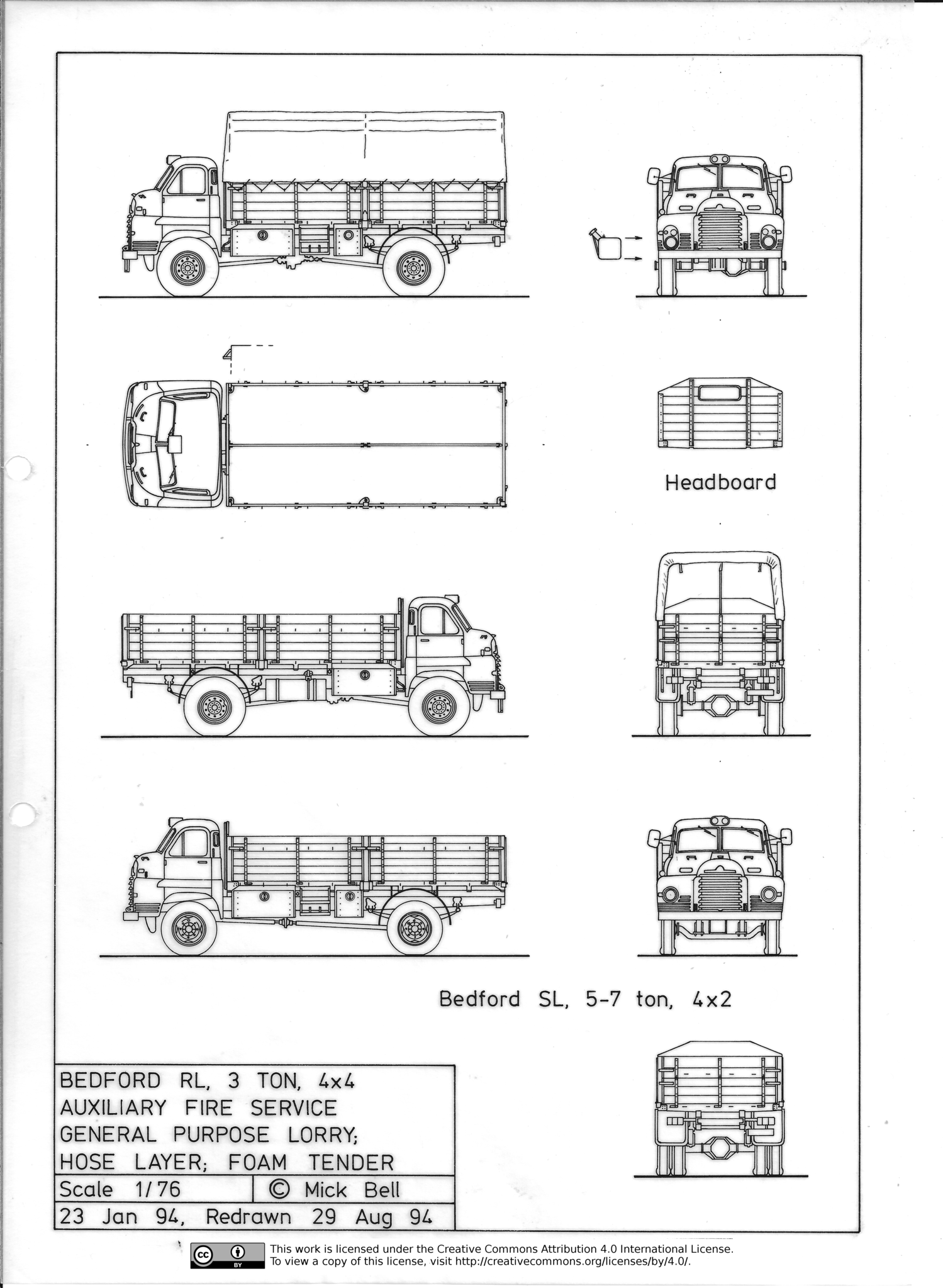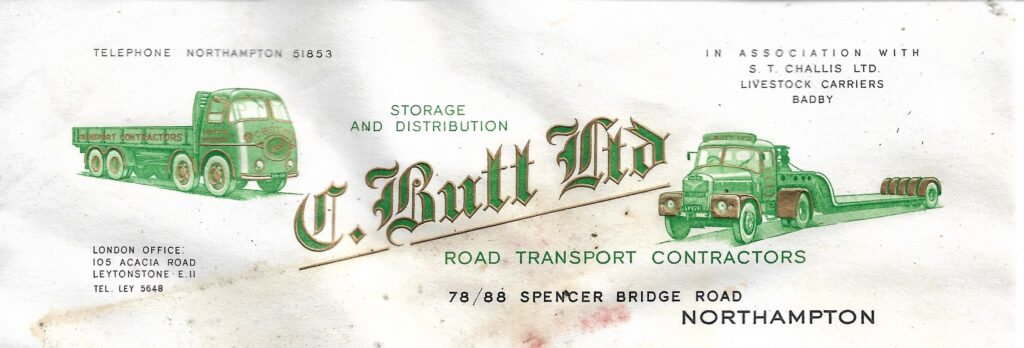
https://www.bedfordenthusiastsclub.com/pages/bedford90.php
Cannonball Tv Series – Video Results
- 25:01Cannonball S01E38 Racket … some classic Canadian TVdailymotion.com
- 20:01Cannonball TV Series 1958 Full Episode Part 1youtube.com
- 26:25Cannonball “Shock” Original air date Dec 29 1958youtube.com
- 20:00Cannonball TV Series 1958 Full Episode Part 1dailymotion.com
- 26:20Cannonball 50s TV Drama episode 1 of 4youtube.com
- 26:38Cannonball Fall out Original air date Feb 23 1959youtube.com
- 25:03Cannonball 50s TV Drama episode 4 of 4youtube.com
- 31:51Cannonball Full Episode Part 2 Small Cargo.flvyoutube.com

gmc cannonball Photo 194136. Complete collection of photos of the gmc cannonball. www.picautos.com 2019
June 16th 2024
ssociated Equipment Company
Tools
Appearance
Text
- SmallStandardLarge
Width
- StandardWide
From Wikipedia, the free encyclopedia
| This article needs additional citations for verification. Please help improve this article by adding citations to reliable sources. Unsourced material may be challenged and removed. Find sources: “Associated Equipment Company” – news · newspapers · books · scholar · JSTOR(November 2017) (Learn how and when to remove this message) |
| AEC Southall Works in 1973 | |
| Industry | Automotive |
|---|---|
| Founded | 1912 |
| Defunct | 1979 |
| Fate | Closed down by British Leyland |
| Headquarters | Southall, England |
| Products | Lorries, buses, motorcoaches |
| Parent | British Leyland (1968–1979) |
Associated Equipment Company (AEC) was a British vehicle manufacturer that built buses, motorcoaches and trucks from 1912 until 1979. The name Associated Equipment Company was hardly ever used; instead, it traded under the AEC and ACLO brands. During World War One, AEC was the most prolific British lorry manufacturer, after building London’s buses before the war.[1]
History
Inception
The London General Omnibus Company (LGOC) was founded in 1855 to amalgamate and regulate the horse-drawn omnibus services then operating in London. The company began producing motor omnibuses for its own use in 1909 with the X-type designed by its chief motor engineer, Frank Searle, at works in Blackhorse Lane, Walthamstow. The X-type was followed by Searle’s B-type design, considered to be one of the first mass-produced commercial vehicles.[2][3]
In 1912, LGOC was taken over by the Underground Group of companies, which at that time owned most of the London Underground, and extensive tram operations. As part of the reorganisation following the takeover, a separate concern was set up for the bus manufacturing elements, and was named Associated Equipment Company, better-known as AEC.[4][5]

AEC’s first commercial vehicle was a lorry based on the X-type bus chassis. With the outbreak of World War I in 1914, AEC’s ability to produce large numbers of vehicles using moving-track assembly lines, based on American principles,[1] became important in supplying the increasing need for army lorries. AEC commenced large-scale production of their 3-ton Y-type lorry in 1916, including some with Daimler-built engines, badged and supplied as Daimler. Continued beyond the end of the war, over 10,000 Y-type lorries were manufactured – making AEC Britain’s largest domestic provider of lorries for the nation’s military.[1] From then on, AEC became associated with both lorries and buses.
Interwar years

In 1926, AEC and Daimler formed the Associated Daimler Company, which was dissolved two years later. In 1927, AEC moved its manufacturing from Walthamstow to a new plant at Southall.[5]
G. J. Rackham was appointed Chief Engineer and Designer in 1928. He had previously worked for Leyland Motors. His ideas contributed significantly to AEC’s reputation for quality and reliability.
From 1929, AEC produced new models: the names of lorries began with “M” (Majestic, Mammoth, Mercury, and so on), and those of buses began with “R” (Regent, Regal, Renown, and so on). These original “M-models” continued in production until the end of World War II. AEC introduced diesel engines across the range in the mid-1930s.
From 1931 to 1938, AEC and English Electric co-produced trolleybuses. AEC supplied the chassis, and English Electric the electric motors and control equipment.
In 1932, AEC took a controlling interest in the British subsidiary of the American Four Wheel Drive (FWD) company, and began to use more standard AEC components in those vehicles. To avoid confusion, these were marketed under the name Hardy. Production ceased about 1936.
World War II

Non-military production stopped in 1941, from then until 1944 AEC produced nearly 10,000 vehicles for the war effort.[6] During the war, AEC produced their 10-ton 4×4 Matador artillery tractor (an adaptation of their commercial 4×2 Matador lorry that exploited AEC’s experience with the Hardy FWD venture).[7] The Matador was used for towing guns such as the 5.5-inch medium gun and the 3.7-inch AA gun. The Matador chassis was used as the basis for the Deacon a self-propelled 6-pounder anti-tank gun, which was used briefly in North Africa.[7]
A 6×6 version was designated as the “AEC Marshall” but almost always called the Matador.
Four hundred AEC Armoured Command Vehicles, popularly known as the “Dorchester” (after the hotel), were built on the Matador and Marshall chassis.[7]
Production of the AEC Armoured Car started in 1941.[7] Three Marks were built, with guns from 40mm to 75mm, totalling 629 vehicles. They remained in use post-war.
Post war



In 1946 AEC and Leyland Motors formed British United Traction as a joint venture to manufacture trolleybuses and traction equipment for diesel railcars since reduced demand would not require the existing capacity of both parents.
In 1946 AEC resumed civilian production with the 0661/20 Regent II and the 0662/20 Regal I. These were not new models but a recommencement of the most basic AEC 1939 specification bus models. The single-decker was going to be marketed as Regal II until somebody at Southall remembered the 1936-8 lightweight 0862 model of that name and as a result the name was corrected after the launch publicity had been printed. At the end of 1946 the postwar 0961 RT was in build and by 1948 Mammoth Major, Matador and Monarch Mk IIIs were in production, followed by the ‘provincial’ Regent III and the Regal III.
Also in 1948 AEC acquired Crossley Motors and the Maudslay Motor Company and on 1 October 1948 AEC set up Associated Commercial Vehicles (ACV) as the holding company for the newly acquired businesses and its own manufacturing firm, which was renamed AEC Limited.[5] The initials AEC remained on its vehicles, with the exception of some badge-engineered versions, such as the Crossley Regent bus. In 1949 ACV acquired the bus coachbuilding company Park Royal Vehicles, along with its subsidiary Charles H Roe. Park Royal designed a new cab for the AEC Mercury in the mid-1950s, which appeared on all models across the range about this time.
In 1961 ACV acquired Thornycroft.[8] The Thornycroft name disappeared from all the vehicles except the specialist airport crash tenders, such as the Nubian, and the Antar off-road tractor unit. Production of the AEC Dumptruk was transferred to Basingstoke, and the Thornycroft six-speed constant-mesh gearbox and later nine and ten-speed range-change versions were fitted to AEC, Albion and Leyland buses and lorries.
The AEC engines were used in Finnish Vanaja lorries and buses in the 1960s.
Leyland takeover
Leyland Motors acquired ACV in 1962. AEC lorries were given the same “Ergomatic” cabs used across several Leyland marques (including Albion). In 1968, all AEC double-decker buses ceased production with the completion of the last Routemasters, and its last buses, motorcoaches and lorries were built in 1979. The AEC name actually disappeared from commercial vehicles in 1977, but the Leyland Marathon was built at the Southall plant until British Leyland closed it in 1979.[9][10] In 1979, the production of Leyland (AEC) vehicles was transferred to remaining Leyland Truck and Bus plants.
Foreign operations
| This section needs additional citations for verification. Please help improve this article by adding citations to reliable sources in this section. Unsourced material may be challenged and removed. Find sources: “Associated Equipment Company” – news · newspapers · books · scholar · JSTOR(April 2022) (Learn how and when to remove this message) |
ACLO
ACLO was the brand name used by AEC in Latin America and in Spain to sell all their products.[citation needed]
ACLOs were principally found in Argentina, Brazil, and particularly in Uruguay, where there were two ACLO fleets (150 buses in total) built by Verheul in the Netherlands on the Regal Mark IV chassis.[11] They were interesting buses, faster than Leyland Tiger in use by other fleets. It was said at the time (early ’60s) that the main reason was inter-urban gearing instead of purely urban gearing present in Leylands. An interesting feature was the preselector gear-change, similar to those in Leyland buses, controlled by a small gated lever installed by the steering wheel, with a reversed gate, with first gear to the right and up, and fourth gear to the bottom and left. In Argentina, 25 Verheul buses also built on the Regal Mark IV chassis were sold in 1961.[12]
In Spain, ACLOs could be seen mainly as double-deck buses in Barcelona, and as line coaches in ALSA fleet.[citation needed]
UTIC-AEC
In Portugal, the AEC vehicles, mainly coaches and buses but also lorries, were assembled and bodied by UTIC, a large coachbuilding firm based in Lisbon and Oporto, and were marketed under the UTIC-AEC badge. AEC based vehicles were market leaders in Portugal, for instance, by the time of creation of Rodoviária Nacional, in 1975, those accounted for 67.5% of the more than 2500 buses and coaches inherited fleet.[13] Production remained strong throughout the late 1970s and would cease in the autumn of 1980.[14]
From 1971 to 1973 the Loughborough based dealer Moseley[15] imported nine UTIC U2043 coaches which were marketed as the Moseley Continental Tagus. They were mechanically equivalent to a rear-engined Reliance or a coach version of the Swift 691 which AEC had planned but never marketed. They were expensive to buy new and the square sided styling looked dated to British eyes in the age of the Elite and Dominant coaches, thus they were slow selling. These were probably the only right hand drive coaches built by UTIC. At the time Moseley also marketed Salvador Caetano Coaches under its own name.
Barreiros AEC
In the late 1950s, Spanish government restrictions on imports reduced AEC sales in Spain to virtually nil. As a consequence, AEC approached a Spanish truck manufacturer, Barreiros Diesel, to jointly produce buses and coaches based on AEC designs. The venture started in 1961, used Barreiros AEC as brand name, disregarding ACLO, and seemed very promising; production of the AEC off-road dump trucks being planned too. Nevertheless, the Leyland takeover in 1962 soon undermined the agreement, as Leyland was partnering with Barreiros’s Spanish arch-rival, Pegaso; and eventually Barreiros looked for another collaborator in the bus arena, signing in 1967 an agreement with Belgian company Van Hool.
Vehicles

Buses
Main article: List of AEC buses
Lorries and other commercial vehicles
Y Type
AEC’s first purpose-built commercial vehicle, the Y Type was introduced in 1915. The improved YA Type appeared in 1917. More than ten thousand of these vehicles were supplied to the War Department by 1919. Many of these were acquired by civilian operators following the war. YB and YC Types continued in production until 1921. Model 201 Model 428 Model 501 & 506 Model 701 Roadtrain
The AEC Roadtrain was an experimental early 1930s road train. Majestic
There were three distinct incarnations of the AEC Majestic:
- Majestic, model 666 (built 1930–36) – 6 ton normal-control lorry.
- Majestic, models 3521/3531 (1950–57) – 10-ton twin-steer (“Chinese six”) 6×2 cabover.
- Majestic, model GB6 (1959–68), – 6×4 variant of heavy normal-control Mogul, built primarily for export and specialist uses.
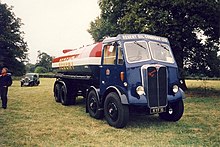
Mammoth
The AEC Mammoth was introduced in 1930, being largest truck in the AEC range and the first to be available as a cabover. It was originally a 7/8 ton 4×2 lorry with a six-cylinder overhead valve engine developing 110 bhp (82 kW) on a wheelbase of 16 ft 7 in. A 6×4 variant was the “Mammoth Major”. From 1934 a distinction was made between the lighter Mammoth Minor, and the heavier Mammoth Major 6 (6×4) and Mammoth Major 8 (8×2 or 8×4), which appeared in 1934. The Mammoth Major Mk II was introduced in 1935; the eight-wheeler could carry 15-ton loads. It remained in production until 1948 when it was superseded by the Mk III, which was mechanically similar, but had the Park Royal cab. Subsequent Mammoth Majors featured the Mk V cab, and finally the tilting Ergomatic cab. The original 4×2 Mammoth and lightweight Mammoth Minor were relatively short-lived models, but both names were later re-used.
- Mammoth, model 667 (1930–34) – 4×2 cabover
- Mammoth Major 6 Mk.I/II, models 668 (1930–35), 366/O366 (1935–48) – 6×4 cabover (Mk.II from 1934)
- Mammoth Major 6 Mk.III, models 3671/3672/3673 (1948–60) – 6×4 cabover (‘tin front’ cab from 1955)
- Mammoth Major 6 Mk.V, models G6 (1959–66) – 6×4 cabover
- Mammoth Major 6, model TG6R (1965–78) – 6×4 cabover (Ergomatic tilting cab)
- Mammoth Major 8 Mk.II, models 680 (1934–35), 386/O386 (1935–48) – 8×4 cabover
- Mammoth Major 8 Mk.III, models 3871/3872/3873/3881/3882 (1948–61)- 8×4 cabover (‘tin front’ cab from 1955)
- Mammoth Major 8 Mk.V, model G8 (1959–66) – 8×4 cabover,
- Mammoth Major 8, model TG8R (1966–78) – 8×4 cabover (Ergomatic tilting cab)
- Mammoth Minor, model 366L (1936–41) – lightweight 6×2 cabover
- Mammoth Minor, model TG6RF (1965–67) – twin-steer (“Chinese six”) 6×2 cabover (Ergomatic tilting cab)
Normal control variants of the Mammoth family were also available, although much less common that the cabovers:
- Mammoth Major 6 Mk.I/II, model 266 (1930–36) and 366 (1936–48) – 6×2 normal control
- Mammoth Major 6 Mk.III, models 2671 (1948–60) and 2621/2631 (1956–62) – 6×4 normal control
- Mammoth Mk.III, model 2421/2431 (1956–62), 4×2 normal control

Mandator
The AEC Mandator name was originally used for medium-duty models in the 1930s, but in 1949 the Matador 4×2 was renamed Mandator. The name was used for the heavier AEC 4x2s until the end of production in the 1970s, and was especially popular as a tractor unit.
- Mandator, model 669 (1931–35) – medium-duty 4×2 cabover
- Mandator, model 672 (1931–32) – medium-duty 4×2 normal control
- Mandator Mk.III, models 3472/3474/3475 (1949–55) – 4×2 cabover. Successor to model 3471 Matador.
- Mandator Mk.III, model 2472 (1949–61) – 4×2 normal-control
- Mandator Mk.III, models 3481/3482/3483/3484 (1955–61) – 4×2 cabover (‘tin front’ cab)
- Mandator Mk.V, model G4 (1959–66) – 4×2 cabover
- Mandator, model TG4 (1965–78) – 4×2 cabover (Ergomatic tilting cab)
Marathon
The Leyland Marathon (1973–79) was a high powered 4×2 or 6×4 tractor unit with a modified Ergomatic cab, which was built at the AEC factory in Southall. A few were given AEC badges to satisfy individual customer preferences. The Marathon name had formerly been used on a Maudslay bus chassis. Marshal
Pre-war 6×4 3ton military lorry built with various body styles- some were employed by the Royal Air Force as cranes (using the Coles Crane). The name was reintroduced for 6×2 and 6×4 medium-duty lorries from the 1960s-1970s.
- Marshal, model 644 (1932/35-41) – 6×4 military truck. Prototypes (1932) included both normal-control and cabover versions, but all production vehicles were cabovers.
- Marshal, model GM6 (1961–66) – 6×2 or 6×4 medium-duty cabover (Mk.V cab)
- Marshal, model TGM6 (1965–77) – 6×2 or 6×4 medium-duty cabover (Ergomatic tilting cab). Variant with larger (but downrated) engine was known as Marshal Major, model 2TGM6
- Marshal 8, model TGM8 (1967–68) 8×4 medium duty cabover (Ergomatic tilting cab)
Matador
The original AEC Matador five-ton 4×2 commercial lorry was introduced in 1932, but the name was most famously used for the 4×4 artillery tractor version introduced in 1938. These vehicles exploited AEC’s experience with four-wheel drive that it had gained from its involvement in the British Four Wheel Drive vehicles marketed under the name Hardy. AEC produced 9,620 artillery tractors; 514 6×6 bowsers for the Royal Air Force; 192 6×6 lorries (some of which had Coles Cranes mounted); and 185 similar vehicles, but 6×4, for mobile oxygen plants. They were known by the nickname “Mat”. New civilian Matadors appeared after the war, and many ex-military Matadors were adapted for post-war commercial use, especially as timber lorries and recovery vehicles. There was a final short run of the 0853 4×4 Matador for the Army in the early fifties, due to ongoing issues with the introduction of the replacement Leyland. The last Matador was a 4×4 variant of the Mercury, introduced in 1960.
- Matador Mk.I, model 645 (1932–35) – 4×2 cabover version of Mercury
- Matador Mk.II, model 346/O346 (1935–47) – 4×2 cabover. Model 236/O246 (1935–40) was the normal-control version
- Matador Mk.II/III, model 853/O853 (1938–59) – 4×4 cabover (Mk.III from 1947)
- Matador Mk.III, model 3471 (1947–49) – 4×2 cabover. Renamed Mandator in 1949
- Matador, model 4GM4 (1960–65) – 4×4 cabover (Mk.V cab, but marketed as “Matador Mk.II”)
The Matador name is often used for the 10-ton 6×6 military vehicles of Model 854/O854 (built 1940–44), but this model was never given an official name. It was an extended Matador chassis, mated to a Marshal double-drive bogie.


Mercury
The AEC Mercury (Model 440) was first built in 1928. This was a forward-control lorry with a wheelbase of 14 ft (4.3 m) for 4 ton payloads. The Model 640 was introduced in 1930, with a four-cylinder petrol engine developing 65 bhp.
The name was resurrected for medium-duty 4×2 lorries and tractors built from the 1950s to the 1970s.
- Mercury, model 640 (1928–37) – 4×2 normal control
- Mercury, model G4M (1953–65) – 4×2 medium-duty cabover. The Mk.I (1953–55) usually had a Duramin cab, whereas the Mk.II (1955–65) usually had Park Royal cabs (‘tin front’ and later Mk.V cabs). Other cab manufacturers included Bowyers. In some export markets this model was sold as Monarch
- Mercury, model TGM4 (1964–77) – 4×2 medium duty cabover (Ergomatic tilting cab). In some export markets (notably New Zealand) this model was sold as a Monarch
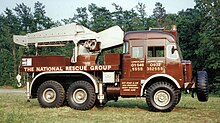
Militant
The AEC Militant – or “Milly” – was the 1952 replacement for the Matador; a 6×4 or 6×6 artillery tractor/military lorry which continued in various forms until the 1970s. The Militant name had earlier been used by Maudslay in the 1930s.
- Militant Mk.I, models O859 and O860 (1952–66) – 6×4 and 6×6 cabover
- Militant Mk.II (1962, prototypes only) – 6×6 cabover (Park Royal Mk.V type cab)
- Militant Mk.III models O870 and O880 (1966–79) – 6×6 cabover. These were the last vehicles to use a variant of the AEC/Park Royal cab.
Mogul
The AEC Mogul model GM4 (1959–67) was a normal-control 4×2 built primarily for export markets. The Mogul name had originally been used on Maudslay lorries. Monarch
The original AEC Monarch was built from 1931 to 1939 at AEC’s Southall works. The first version had payload of 7 tons (increased to 7+1⁄2 tons from 1933) and was fitted with either an 85 hp (63 kW) four-cylinder 5.1-litre diesel engine or an 80 hp four-cylinder 5.1-litre petrol engine. This was a robust and well-designed lorry, popular with both drivers and operators. The model was discontinued in the 1950s, although the name lived on into the 1970s in some export markets. TL 3513 (1934) KYE 402 (1949)
- Monarch Mk.I, models 641 (1930–33) and 647/648 (1933–35) – 4×2 cabover
- Monarch Mk.II, models 344/346/O346 (1935–47) – 4×2 cabover. There was also a normal-control version, model 244 (1935–40)
- Monarch Mk.III, models O345/3451 (1947–56) – 4×2 cabover
- Monarch, model TGM4 (see Mercury TGM4)
Mustang
The AEC Mustang model GM6 (1956–61) was a medium-weight, twin-steer (“Chinese six”) 6×2 cabover, derived from the Mercury Dump Trucks
From 1957 to 1971 AEC built a series of large off-road dump trucks:
- Model 3673M (1957–63) – 6×4 half-cab derived from Mammoth Major, with 10 cubic yard dump dumper capacity
- Model HDK4 (1959–65) – 4×4 normal-control with 18 cu/yd capacity
- Model DK6 (1961–62) – 6×4 or 6×6 semi-cabover derived from Militant, 10 cu/yd capacity.
- Model BDK6 (1964–71) – normal-control 6-wheeler, 10 cu/yd capacity. Based on Thornycroft design. Also sold as under the Leyland, Aveling Barford and Scammell brands
Railcar engines
Main articles: GWR railcars, British United Traction DMUs, and AEC railmotor
Centenary celebrations
2012 was the centenary of the founding of AEC Ltd, and to mark this, a number of events took place throughout the year. By far the biggest was hosted by The AEC Society, and was held over the weekend of 26 and 27 May 2012 at Newark Showground in Nottinghamshire. It was the biggest ever gathering of AECs vehicles, and over 225 attended, as well as more than 350 vehicles of other marques. It was the biggest rally ever held by The AEC Society and was closed by a flypast by the Battle of Britain memorial flight.[citation needed]
See also
- Hobart’s Funnies Associated Equipment Company in World War 2
References
Baldwin, Nick (2010). Lorries : 1890s to 1970s, Shire Library. Bloomsbury Publishing. p. 12. ISBN978-0747811886. Retrieved 14 September 2021. “From omnibus to ecobus, 1829-1850”. London Transport Museum. Archived from the original on 9 June 2007. Retrieved 3 July 2007. “From omnibus to ecobus, 1919-1938, 4th page”. London Transport Museum. Archived from the original on 9 June 2007. Retrieved 3 July 2007. “From omnibus to ecobus, 1919-1938, 3rd page”. London Transport Museum. Archived from the original on 8 June 2007. Retrieved 3 July 2007. Companion to Road Passenger Transport History. Walsall: Roads & Road Transport History Association. 2013. pp. 31/32. ISBN9780955287633. “AEC’s Contribution to Victory”. Commercial Motor Archive. 20 April 1945. Retrieved 21 October 2023. Ward, Rod (2017). AEC Album Part One: to 1945. Zeteo Publishing. OCLC1014414977. AEC-Thornycroft Merger Announced in England Truck & Bus Transportation March 1961 page 5 AEC plant closes as Marathon movesCommercial Motor 17 November 1978 Southall’s last TL12 MarathonCommercial Motor 20 April 1979“Anglo-Dutch bus for South America”. The Commercial Motor. 14 December 1962. p. 50. “BusARG.ar – Primer Museo Virtual del Transporte Argentino”. www.busarg.com.ar. Retrieved 8 February 2024. Manning, Ian (2009). Portuguese Buses Volume Three – The Bus Fleets Of Rodoviária Nacional – The Portuguese National Bus Company – 1975-1995. Coydon: DTS Publishing. p. 11. ISBN978-1-9005 15-24-5. Manning, Ian (2009). Portuguese Buses Volume Three – The Bus Fleets Of Rodoviária Nacional – The Portuguese National Bus Company – 1975-1995. Coydon: DTS Publishing. p. 6. ISBN978-1-9005 15-24-5.
- “Contact Us – Moseley Coach Sales”. Archived from the original on 4 November 2012. Retrieved 6 October 2014.
External links
- AEC Society
- Remembering AEC
- The AEC Bus Site
- AEC Matador and Militant Owners Club
- The British/Portuguese UTIC AEC Coaches
- Page on ALSA’s ACLO buses
- Home of a famous Militant Mk1
- Catalogue of the AEC archives[permanent dead link], held at the Modern Records Centre, University of Warwick
- Associated Equipment Company
- Companies based in the London Borough of Ealing
- Defunct bus manufacturers of the United Kingdom
- Defunct truck manufacturers of the United Kingdom
- Former defence companies of the United Kingdom
- History of the London Borough of Ealing
- Leyland Motors
- Motor vehicle engine manufacturers
- Southall
- Trolleybus manufacturers
- Vehicle manufacture in London
- Vehicle manufacturing companies established in 1912
- Vehicle manufacturing companies disestablished in 1979
- 1912 establishments in England
- 1979 disestablishments in England
- British companies disestablished in 1979
- British companies established in 1912
March 21st 2024
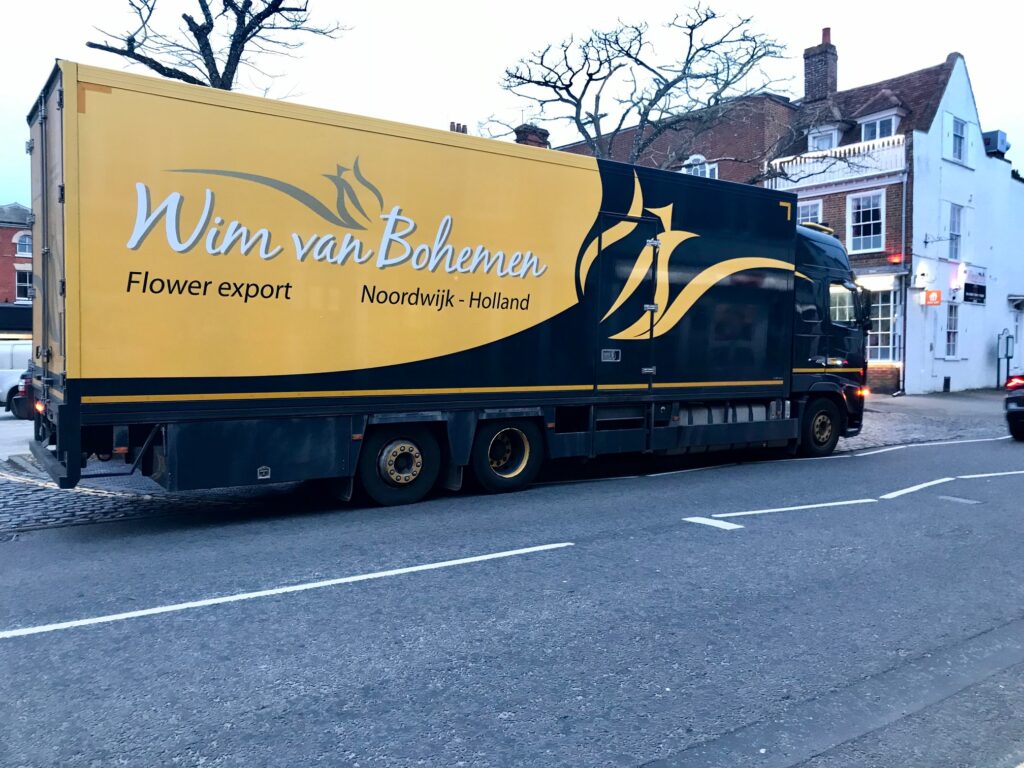
January 26th 2024
gmc cannonball Photo 194136. On our site you can find many photos of gmc cannonball and other cars.
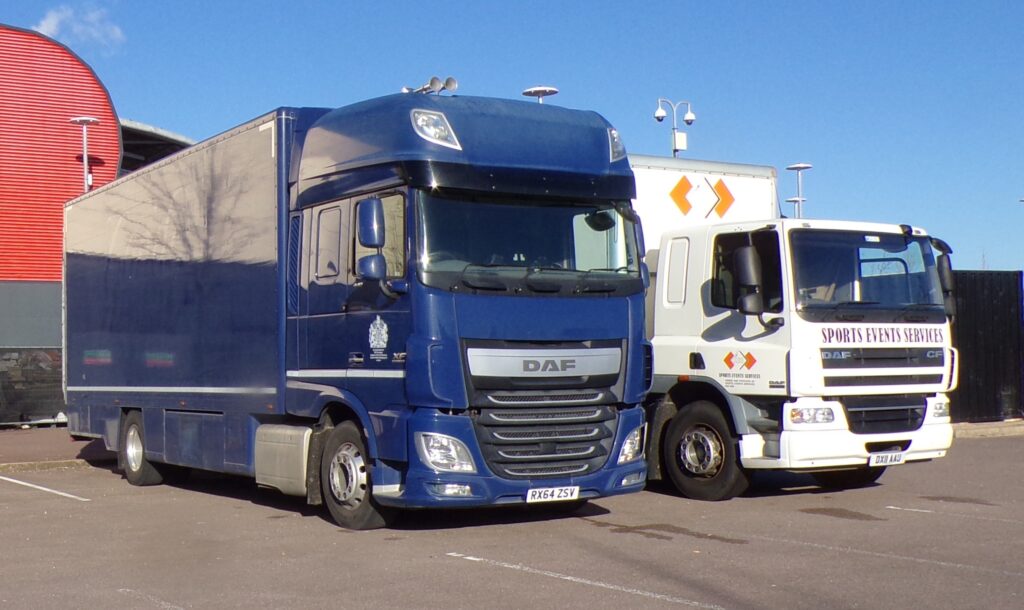

December 27th 2022
BMC/AUSTIN/LEYLAND TRUCKS
205 Pins
5hA
Collection by
Similar ideas popular now

TrucksCommercial VehicleVehiclesAustinClassic Truck




December 25th 2022
https://truck-encyclopedia.com/coldwar/UK/Bedford-RL.php
Bedford RL (1953-1973)
Early Cold war British Medium Truck standard
The Bedford RL (later TK) represented the bulk of British motorized regiments mount for the entire cold war. The RL had the hard task to replace the otherwise excellent QL series of WW2. This was an army vehicle derived from the civilian SCL 7-ton truck. The military version had the all wheel drive and larger wheels, plus increased ground clearance. It was rated at 3 tons originally, as all RL GS (general service) trucks in the British Military. Later, they were re-rated at 4 tons, but without mechanical modifications, the figure indicating now rated cross country payload weight. The last RL left Bedford’s production line in 1973, for a grand a total of 74,000 vehicle. This was even far more than the wartime QL series (52,247), and for this reason it became the standard British military truck for most of the cold war.
Development of the Bedford series R
Design and development of the R-series started in December 1950, by Vauxhall Motors Limited. A single prototype was sent to Fighting Vehicle Research & Development Establishment (FVRDE) in May 1951. There, the chassis was validated and given the FV13100 series number. Production started in April 1952 at Vauxhalls Trucks, Luton. Headlights were moved down in order to comply with British regulations and the radiator grille was later modified while it also reached the civilian marker from October 1953, declined in many body styles and variations (with/without dual rear tyres for example). The army also obtained and tried an armoured open-top cab variant.
The R-range started to appear in infantry units and other services from 1952 in the British Army, replacing advantageously the WW II Bedford QL, but also the Austin K5 and Ford WOT6. It retained its generic truck appelation “3-tons”, which equates to “medium”, but it was later up-rated to a 4 ton capacity in 1968. On the production line, it was replaced by the M-type.
Design of the Bedford 3-tons
Powerplant: The RL had a 4.9 litres (299.0 cu in) petrol engine, rated for 110 brake horsepower (82 kW; 112 PS). Some were equipped also with diesel engines.
This engine was mated on a Bedford 4WD chassis cab, chassis being mounted by drilling rig at the Ruston-Bucyrus facility. Specialist variants comprised recovery vehicles, mobile workshops, radio vans and cable layers and the fire engine “Green Goddess”. The R-series resued the 7-ton SLC-chassis and kept both the engine and cab. The RL was the “long” version (L = long wheelbase) while the RS was the shorter version (S = short wheelbase) both produced alongside.
The basic cargo vehicle had a fixed-sided steel body, later modified as drop-sided, with a drop tailgate, and the payload protected by canvas cover supported by a tubular framework. The base vehicle was unarmed, but some users modified the cab to introduce a gunner’s hatch.
There was a choice of Engines from Bedford/ At first the 6-cylinder 4.930 cm3 (300 cubic inches) in displacement, petrol, was the standard. Later a 6-cylinder 5.410 cm3 (330 cubic inches) diesel engine, liquid cooled was proposed. Te former developed 115 hp at 3000 rpm (petrol) and the latter 99 hp at 2600 rpm. Fuel capacity rested on a main tank of 118 liter (25 gallons) allowing for a range of 400 km (250 miles) – actually it was less than the Bedford of WW2. Transmission was a 4-speed model with a 2 speed transfer case. Electrical system rested on a 12 volt, negative ground (early models, positive ground) battery. For mobility the vehicle had Hydraulic brakes, servo-assisted. It mounted 11.00 – 20 tyres. On trials it was tested able to fordi about 0.76 m (30 inches) without preparation, but it was also provided with a deep water fording kit. In option, the vehicle could be equipped with a 5 ton Turner winch driven by a power take-off.
Variants
- Bedford RLE office van
- Bedford RLW GS
- Bedford RLE TTY van
- Bedford RLC Facility Control truck
- Bedford RLH HF radio truck
- Bedford RLC Radio HF truck
- Bedford RLC cable layer
- Bedford RLC telephone construction
- Bedford RLC telegraph maintenance
- Bedford RLC spare parts van
- Bedford RLE spare parts van)
- Bedford RLE Direction Finder Center
- Bedford RLE NBC squad truck
- Bedford RLE electronic maintenance
- Bedford RLG Tipper
- Bedford R-series Command and Control
| Bedford RL (Long Wheelbase) specifications | |
| Lenght | 6.35 m (247 inches) |
| Width | 2.45 m (95 inches) |
| Height | 3.35 m (130 inches) |
| Total weight, battle ready | 8.025 kg (17.655 lb.). |
| Crew | 2 + 12-16 infantry |
| Propulsion | Bedford 6-cylinder gas. or diesel, see notes |
| Suspension | Leaf springs |
| Speed (road) | 50 kph (60 mph) |
| Range | 400 km (250 mi) |
| Armament | None (personal weapons) |
| Production | 74,000 (RL+RS) 1952-73. |
Service
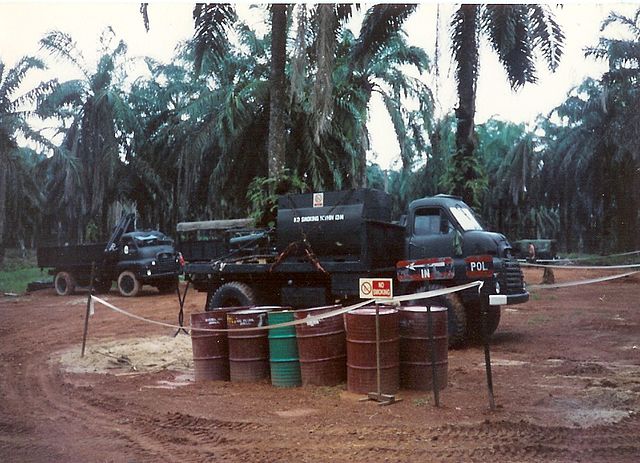
One of the last appearance of the Bedford RL, fuel-tank version, here the NZ-built version in the NZAOD exercize in 1988 at Kerbside refuelling point.
The RL equipped all units previously given the QL series. The RL and variants continued to serve alongside the later Bedford MK and Bedford TM trucks until well into the 1990s. The mythical TL was not replaced by the TK which was built in parrallel from 1959, but by the TL range in the 1980s. The RL and variants nevertheless continued to serve alongside the later Bedford MK and Bedford TM trucks until well into the 1990s.
The Home Office also purchased many of such vehicles to be placed reserve for a national emergency. They were disposed of recently and reached the civilian market some with just 2,000 miles (3,220 km) on counter.
The Danish R type
The Bedford R-series entered service in the Danish Army in 1956, as standard medium truck. Some RLC5 chassis were delivered to GM International, Copenhagen to be refitted locally with new upper-cabs and bodies, patterned on US Army post-war vehicles. The RL saw was declined into Command and Control, Office-vans, Switchboards, Teletype and other versions as well in Danish service. There was a second batch of around 375 units bought in 1963-1967. Now all were replaced by the Magirus Deutz 168 M11FAL (IVECO 110 – 16 AWM).
It was assimilated to the Assault Class 30 trackway equipment upplied as a standard between NATO countries, all by Laird Company in UK. These were used for soft ground, up to 30 tons. The kit comprised 32 meters of trackway, setup by a team of 5 men in about 10 minutes and removed in about 15 minutes.
The Australian R type
There was also the Australian R serie used from the 1960s to the 1980s by Victoria’s Country Fire Authority (CFA). They were modified wiith a 800 gallon water capacity, 4 wheel drive bushfire tankers, known as “State Spare Tankers”. They were larger than most brand rural fire attack tankers, and bolstered other models. They were painted in the CFA’s standard “Carnation (dark) Red”, fitted with rear Godiva pumps (2,250 litres per minute output).
The Malaysian Army RL
The Malaysian Armed Force (ATM) purchased ans used Bedford RL trucks from the mid-1960s to the mid-1980s. They were mostly used for logistics, troop and ammunition transport. They were given two rows of wooden bench along the entire bed, lined along opposite bed edge and a central nacl-to-back bench to maximize troops capacity. This seating compartment was covered by a tarpaulin supported by steel-tube frame like for the british version. The Driver and co-driver took place in an unchanged cab, but a machinegunner hatch was installed on it roof. The other difference with the Civilian market vehicle was its enhanced 4×4 features. They were phased out in the Malaysian army by the Mercedes Benz L Series and the Hino Ranger TK, starting frim the late 1970s. Bedford RL has been deployed in the Konfrontasi conflict and Second Malaysian Insurgency.
Singaporean Army Bedford RLs
The Singapore Armed Forces also operated the Bedford RL from the mid-1960s to the late-1970s, mostlt as troop transport and logistics (food, ammo, water and spare parts). The entire infantry platoon, including its 60mm mortar team could and ammunition crates could fit into just one RL truck. Seating was the same as for the Malayrian truck, with wooden bench facing inside and each other. The vehicles were likely handed-down from the British military after Singapore gained independence in 1965 and until 1971. They were slowly phased out by the Mercedes lorry, and in the Singaporean nomenclature they were called “3-tonners”. Complete withdrawal was done in 1978.
New Zealand’s Bedford RLs
The Bedford RL became also the main troop transport in the New Zealand military, from 1958 to 1989. The main difference was it was not purchased, but built locally under licence in New Zealand. Some were aso resold in the South East Asia. Arrangements were pretty similar to the British version, and unarmed. The NZ Bedford RL was gradually replaced by the Mercedes Benz UNIMOG. The New Zealand Army also used several versions such as the GS, the Tipper,and several Recovery and Mobile workshops.
Others users
Within NATO, Belgium, Ireland, the Netherlands also used it. The vehicle was also exported to Pakistan and South Africa.
Testimonies:
Anon
“I like this shape of truck, just reminds me when my father took me with him on his work about 40 years ago. Went from a 650 BSA to an RL in 1970 with the Marines at Eastney, passed first time, smashing to drive, still amuses folk when I tell then I have never taken a test in a car, especially the salesman who accompanied me on a test for a new car last year, thought he was about to have a heart attack. I was stationed with Royal Scots Greys in Germany and after some fiddling with the governor we actually saw 90mph out of one of them, it was quite frightening, but fun to see our ferret “escort” disappear behind us. Legendary vehicle, soldier-proof with unreal cross-country performance… The GPO registration ELP737C (Simon Polecat) is just readable. One of 60 Polecats registered in May’65. Another batch of 40 Bedfords from ELP773C up were fitted with King Tel-e-lect cranes. The easiest way to disengage four wheel drive in an RL…was to engage reverse gear, take up the clutch and then push the lever. EASY, when you knew how !.”
Blue Roan.
“My memory of the RL truck in Germany in the 60’s is of a lovely big softie. Powerful enough and easy to drive. No need to double declutch as I found once – rounding a very tight corner I changed down to bottom and on driving away though there was something funny about the change. I had double declutched with tha dip switch! No prob. Also, on ice, you could wind on full lock quickly and unwind it quickly, and the RL would travel straight on without a twitch. Useful?”
Eddie H.
Passed my driving test in the bedford RL in portsmouth 1964 whil`st stationed at bordon hants REME loved this vehicle.
Roelf
“I passed my HGV test in the army in 1981 in a Bedford RL. It was awful!. I passed :-)… I do remember that when trying to get the beast out of 4 wheel drive the easiest way was to try and hit 20 mph in 3rd gear (took ages !), dip the clutch, and then throw the transfer lever down. To do this you almost had to dislocate your left shoulder, as the lever was in such an awkward position high up between the 2 seat backs. If you didn’t know how to double de-clutch then there was no way you were going to drive this vehicle. Power steering ? no way !. In 1984 I drove an RL down to the island of Elba from my base in Germany, two and a half days later we got there at an average speed of 40 miles per hour. The only way to keep warm in this vehicle was to prop the engine cowling open and rely on the heat from the engine filling the cab. This also had the added benefit of allowing us to heat our tinned “compo” rations by placing them on the exhaust manifold. Aaaah ! happy memories !”
Scr: https://web.archive.org/web/20170211222741/http://y2u.co.uk/%26002_Images/Bedford%20RL%2001.htm
Src/Read More
JANE’s Military Vehicles and Ground Support Equipment, 1985
Army Sustainier Magazine. RNZALR. August 2010. p. 41, Issue 2.
“Repairs to the Heavy Workshop RL Bedford”. armymuseum.co.nz. Retrieved 6 October 2016.
On the Bedford RLG
On armyvehicles.dkun-bedford-en-el-crater.htmlOn wikipediaModels kits on scalemate
Gallery of models
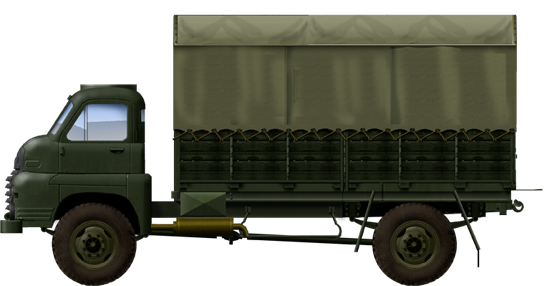
Early Bedford RL, late 1950s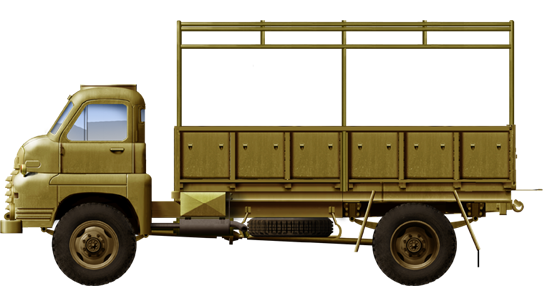
| See Homepage. | This page: Various photos of Bedford RL trucks driven during a stint of National Service in the Army. |
Bedford RL Army lorries. 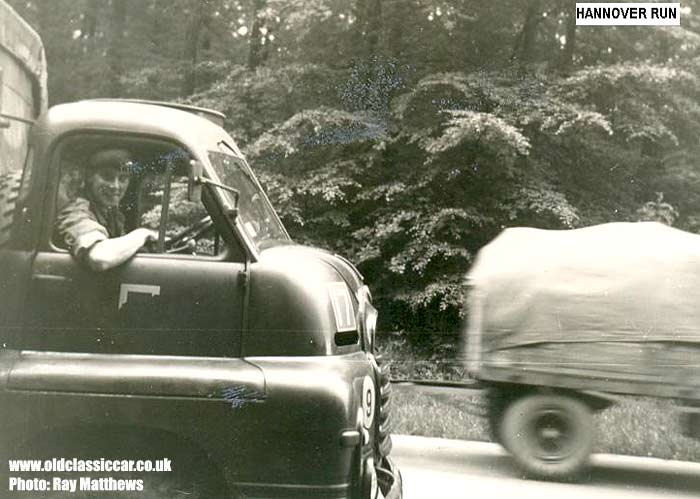 Firstly, I’m indebted to Ray who sent me these photographs, taken during his service with the British Army during the 1950s. The Army RL was in effect a military version of the civilian S-Type lorry, albeit with 4×4 running gear as opposed to the civilian S-Type’s 2wd arrangement. The first photograph, shown above, has a young Ray at the wheel of his Bedford, en route to Hanover in Germany.  Ray’s regular steed was this RL, registration number 12 CE 72. The front of these lorries is perhaps most often associated with the Green Goddess fire appliances used from the 1950s well into the new millenium, as the front end tinwork was almost identical. The militarised RL was a very different machine under the skin though. Ray’s regular steed was this RL, registration number 12 CE 72. The front of these lorries is perhaps most often associated with the Green Goddess fire appliances used from the 1950s well into the new millenium, as the front end tinwork was almost identical. The militarised RL was a very different machine under the skin though.The RL was fitted with a 6 cylinder petrol engine as standard, producing 110bhp and proved sufficient to pull this 3-ton rated lorry around. The RLs in service were upgraded to 4 ton capacity in 1968. Apparently over 73,000 RLs were produced, with the model first being offered to the public in August of 1952. Next up are two photographs again featuring Ray’s Bedford. To the left is a shot of his lorry parked up at the Hamelin Barracks, being washed down by hose, and alongside a shot from inside the cab, as driver and vehicle cross the River Weser, a river that runs down through Bremen, passing close to Hannover and southwards in the general direction of Frankfurt, albeit some way to the East of this city. 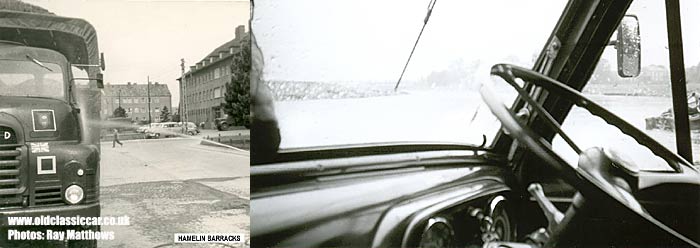 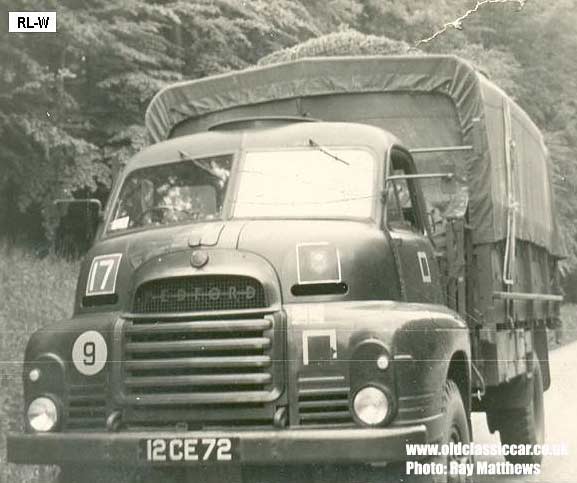 Next in this mini-assortment of Bedford RL photographs, is this front three-quarter view of the RL-W Bedford, complete with its GS rear body and canvas tilt. Next in this mini-assortment of Bedford RL photographs, is this front three-quarter view of the RL-W Bedford, complete with its GS rear body and canvas tilt.As with most military vehicles, these Bedfords ran on bar-grip tyres, designed to offer decent traction in varying road and off-road conditions. They could however clog up as this tyre design isn’t always at its best on mud once the grooves have clogged up, but overall they are the best compromise. On the road though they can give a hard, and noisy, ride. No power steering in those days either, so drivers of lorries back then had to be made of stern stuff. 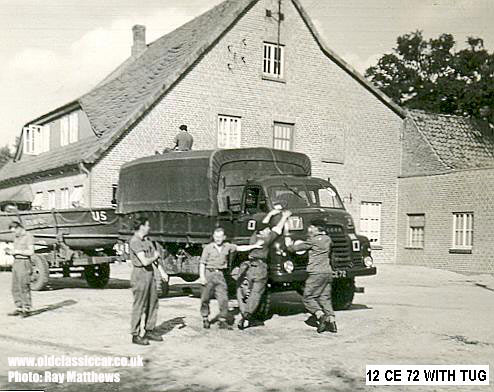 The final picture shows Ray’s RL parked up, with a tug boat and trailer hitched to the rear. All these photos were taken while Ray was on National Service, where he was a ‘sapper driver’ delivering and collecting various rations and hardware. Much of his time was spent in and around Hanover, and was stationed close by to the VW factory there. Some photos of the Volkswagen factory will feature on the site shortly. The final picture shows Ray’s RL parked up, with a tug boat and trailer hitched to the rear. All these photos were taken while Ray was on National Service, where he was a ‘sapper driver’ delivering and collecting various rations and hardware. Much of his time was spent in and around Hanover, and was stationed close by to the VW factory there. Some photos of the Volkswagen factory will feature on the site shortly.Thanks again to Ray for sending these photos over, and allowing them to be featured at oldclassiccar! Original photographs of this model’s predecessor, the OY, can be found on this page of the site. |
| Return to the old transport photos – Page 5. |
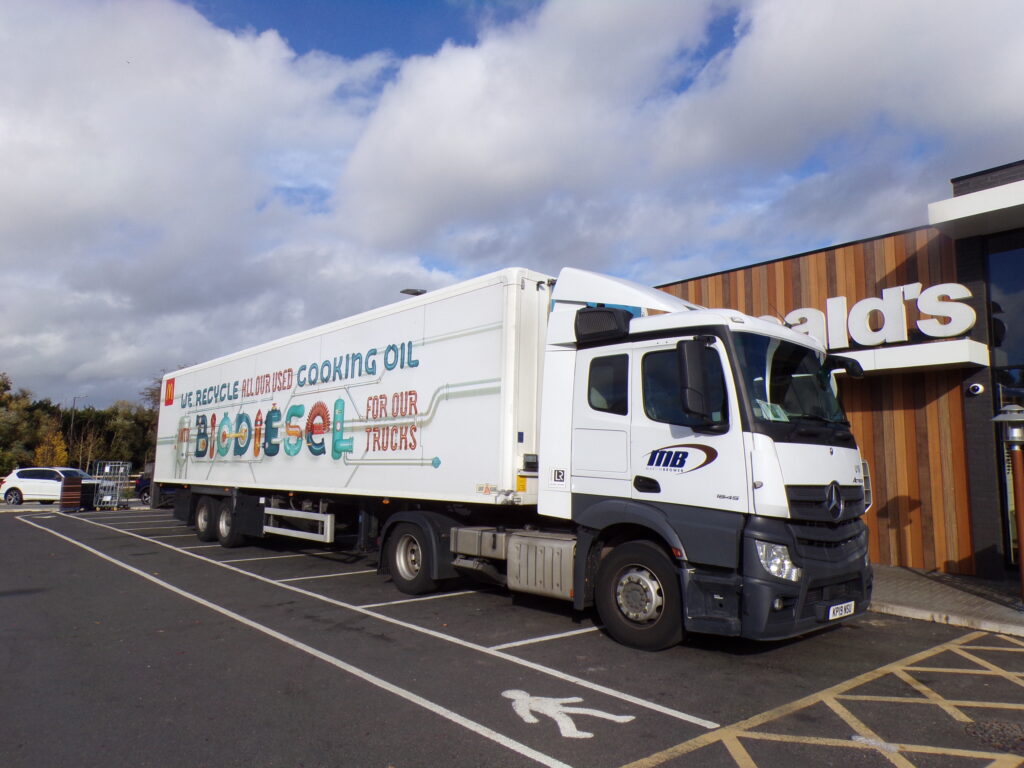
September 1st 2022
Off The Road
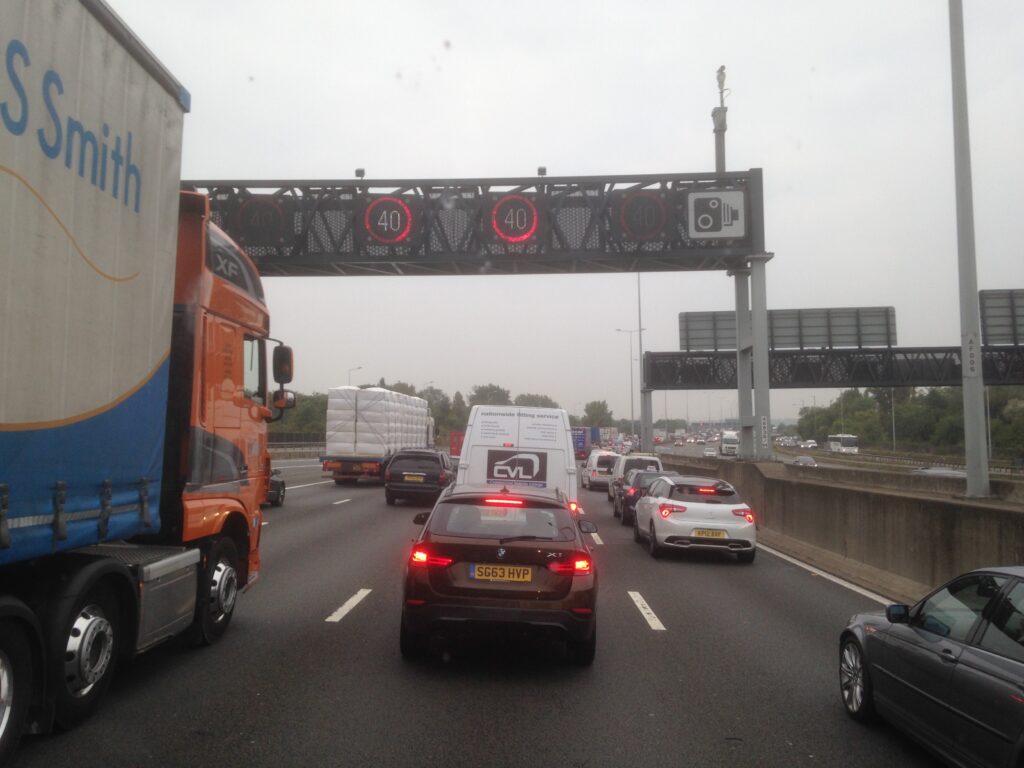
I miss life on the road and all the money I have lost, not to mention refusing anti psychotic drugs as a condition of completing my sex change treatment and surgery. My fellow travellers don’t know how lucky they were that I didn’t have an episode that day or any other. It is obvious that posh cosseted overpaid doctors think truck drivers are morons.
Image R J Cook / Appledene Photographics.
July 10th 2022
70,000 Self-Employed Truckers in California Face Shutdown Under New State Law
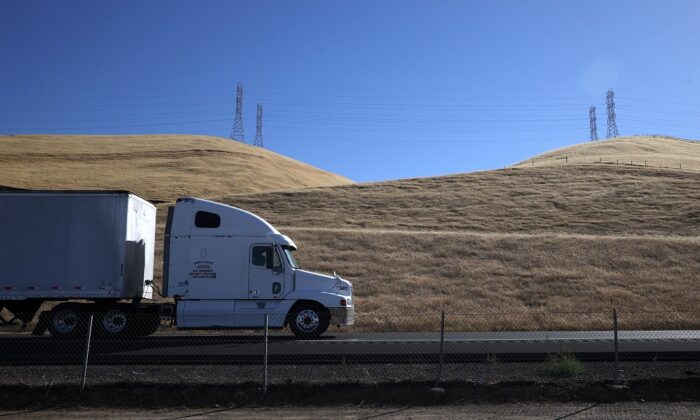
A truck drives by hills covered in dry grass along Highway 5 in Los Banos, Calif. on May 25, 2021. (Justin Sullivan/Getty Images)
Industry says it’s ‘pouring gasoline’ on supply chain crisis By Allan Stein July 8, 2022 Updated: July 9, 2022
Tens of thousands of independent California truck owner-operators could be out of business soon under a new statewide worker classification law designating them as employees.
On June 30, the U.S. Supreme Court denied a review on whether California Assembly Bill 5 (AB-5) violates the Federal Aviation Administration Authorization Act of 1994 as it applies to self-employed truck drivers.
“Gasoline has been poured on the fire that is our ongoing supply chain crisis,” the California Trucking Association (CTA) wrote in a June 30 response to the high court’s decision regarding the association’s legal challenge to the bill.
“In addition to the direct impact on California’s 70,000 owner-operators—who have seven days to cease long-standing independent businesses—the impact of taking tens of thousands of truck drivers off the road will have devastating repercussions on an already fragile supply chain, increasing costs and worsening runaway inflation,” the association added.
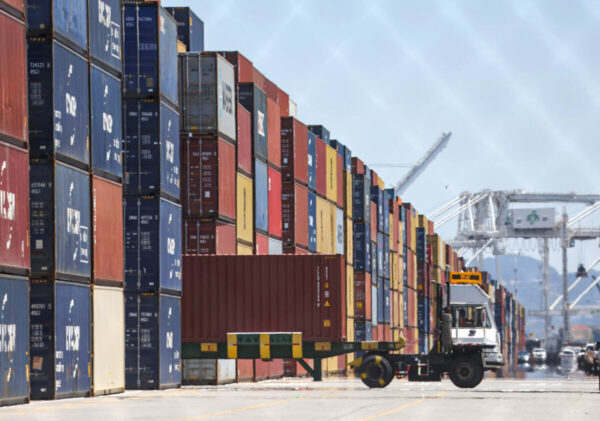
“We are disappointed the court does not recognize the irrevocable damage eliminating independent truckers will have on interstate commerce and communities across the state.
“The legislature and [Gavin] Newsom administration must immediately take action to avoid worsening the supply chain crisis and inflation.”
The California State Assembly adopted AB-5 in September 2019, sparking CTA’s legal challenge and the Supreme Court’s latest decision.
The bill’s primary sponsor was Lorena Gonzalez (D), a union leader and former Assembly member.
Under AB-5, a self-employed commercial truck owner must satisfy a three-part test to be considered an independent contractor, with exceptions for construction trucking services.
The bill adds that existing law “creates a presumption that a worker who performs services for a hirer is an employee for purposes of claims for wages and benefits arising under wage orders issued by the Industrial Welfare Commission.”
Existing law defines employees for purposes that include “any individual who, under the usual common law rules applicable in determining the employer-employee relationship, has the status of an employee.”
Self-Employed Truckers Entitled to Benefits
The bill would entitle those self-employed truck drivers and owners to the same benefits and workers’ compensation as regular employees.
According to Globecom Freight Systems, a leading provider of transportation services, owner-operators make up 9 percent (350,000) of the commercial truckers on the road today. Their average salary is about $50,000.
A recent study by the American Trucking Association found that the nationwide shortage of 80,000 truck drivers could double by 2030. In light of the shortage, many trucking companies now offer lucrative sign-on bonuses and salaries to attract more drivers.
The Federal Motor Carrier Safety Administration recently launched an apprenticeship driver program for those aged 18–to–20 that would allow them to cross state lines to help further alleviate the shortage.
Tony Bradley, president and CEO of the Arizona Trucking Association, criticized AB-5 as a “horribly misguided piece of legislation” by California labor unions that will have a “drastic impact across all trucking.”
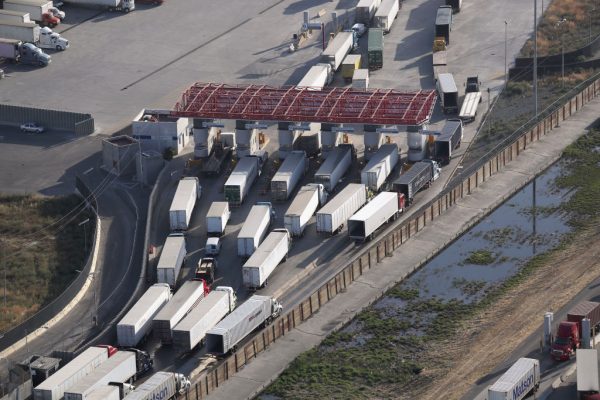
“It’s unclear at this point how it will affect owner-operators that don’t live in the state of California,” Bradley told The Epoch Times.
“We are evaluating and looking at it closely, but putting 70,000 people out of work is not the thing to do when we have raging inflation and supply chain issues.”
“How are people supposed to follow their dream of starting their own trucking company if they can’t be their own boss? In California, they’ve effectively stopped that practice,” Bradley said.
Bradley said that today, 97 percent of all trucking company fleets include 10 trucks or fewer, and every large company began with “one truck.”
He said AB-5 will force independent truck owner-operators to join an established trucking company or “follow some other career path.”
“This was largely run by the California labor unions, who find it difficult to unionize people who work for themselves. I think it will have a huge impact on our industry and economy,” Bradley said.
Given Arizona’s proximity to California, the world’s third-largest economy, Bradley said it’s challenging for Arizona independent truck owner-operators not to do business in California.
“I think some of them will exit the business and pursue other dreams [though] we don’t know what the repercussions will be for out-of-state drivers,” Bradley said.Allan Stein Follow Allan Stein is an Epoch Times reporter who covers the state of Arizona.
July 7th 2022
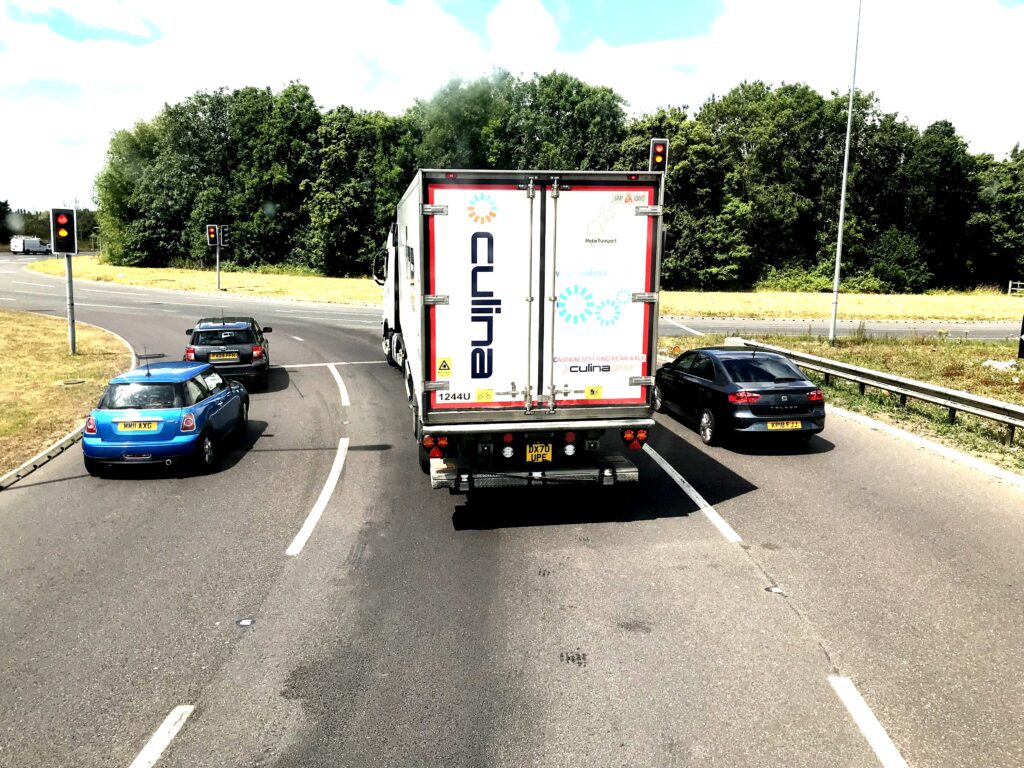
Image Appledene Photographics/RJC
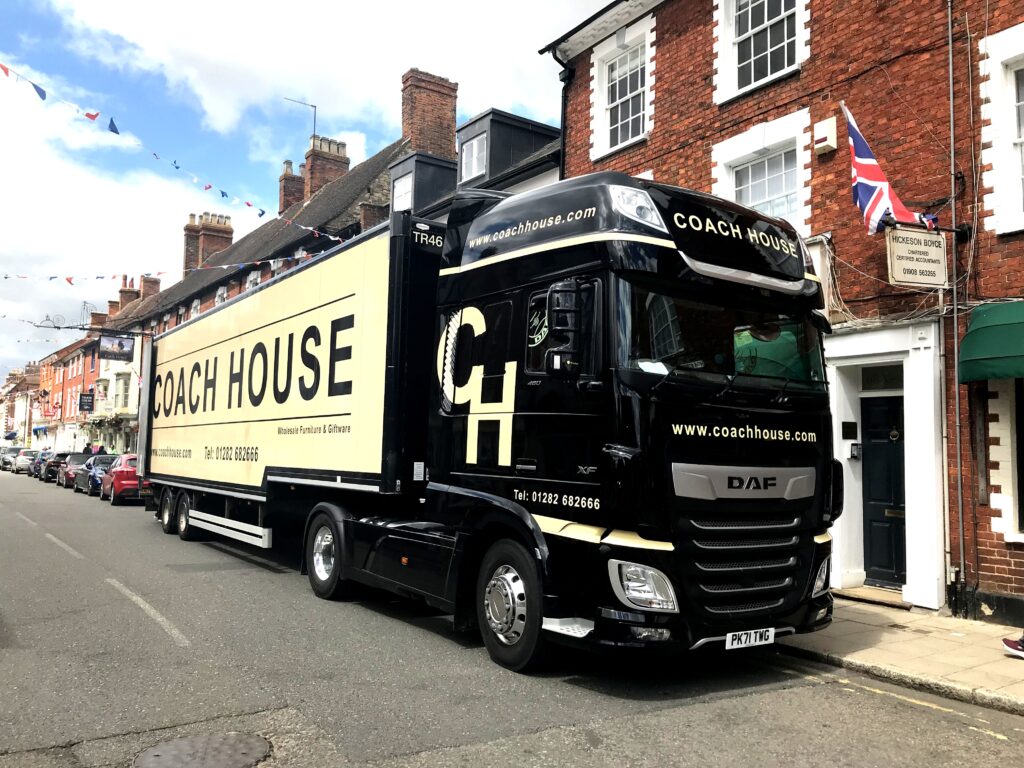
Image Appledene Photographics/RJC.
Trucking it up – May 3rd 2022
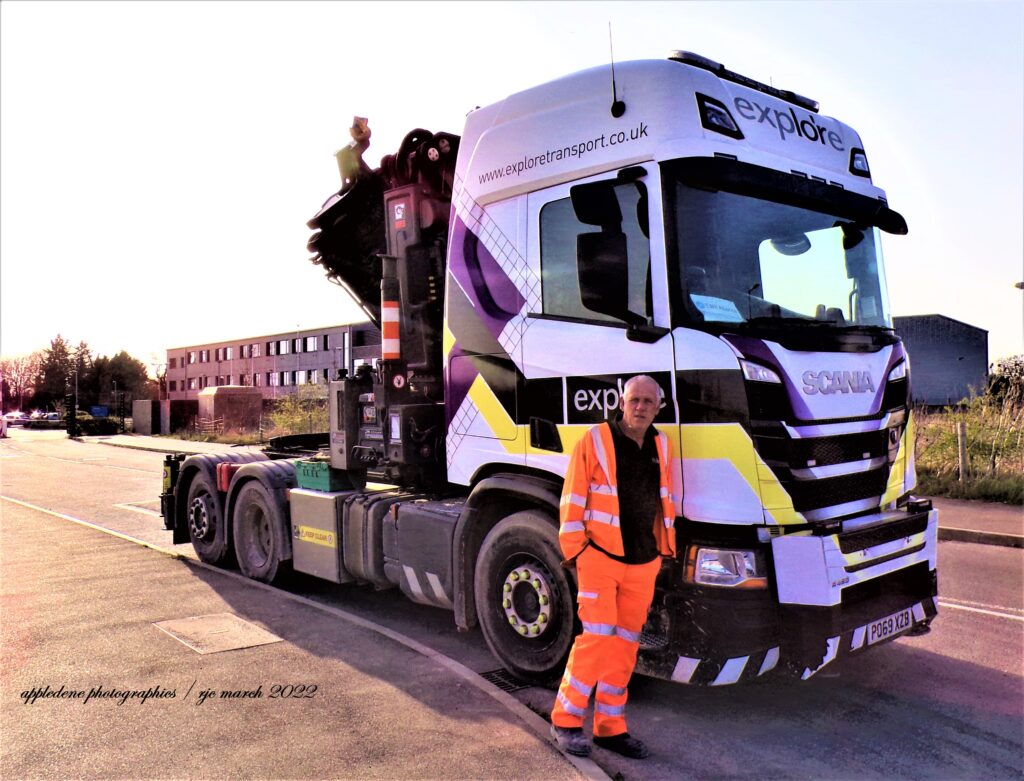
East West Rail Agregate Tippers Smashing Up Local Bucks Roads.
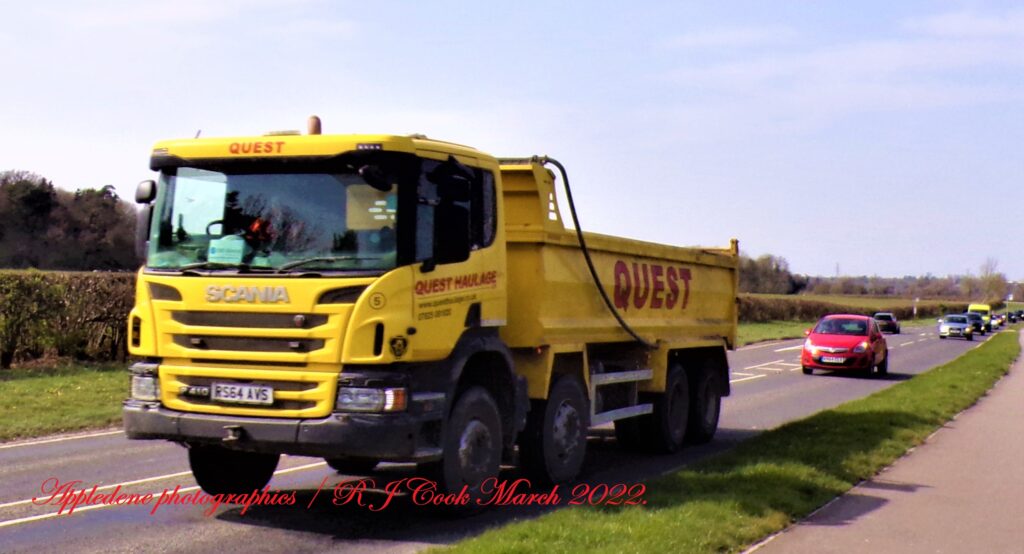
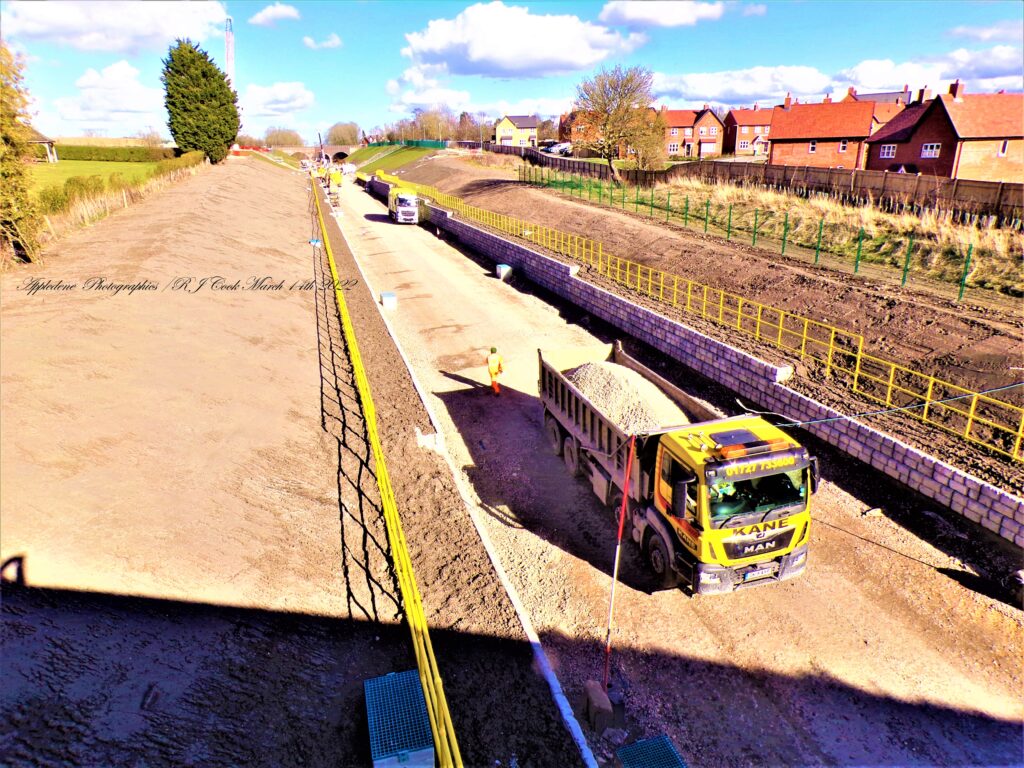
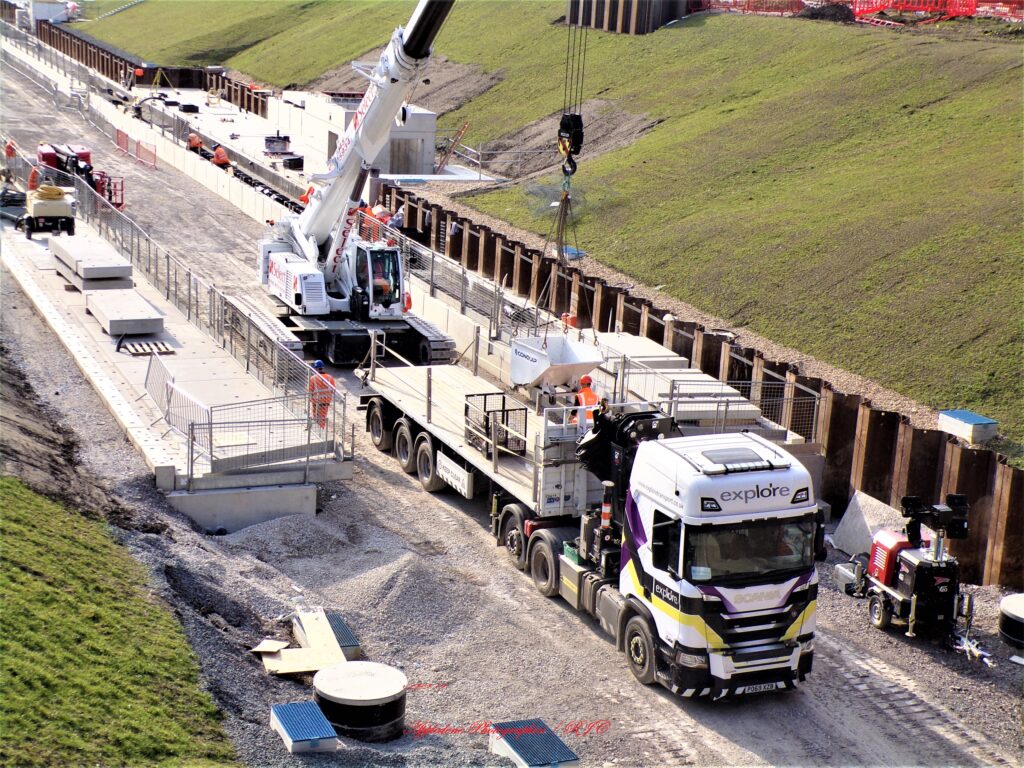
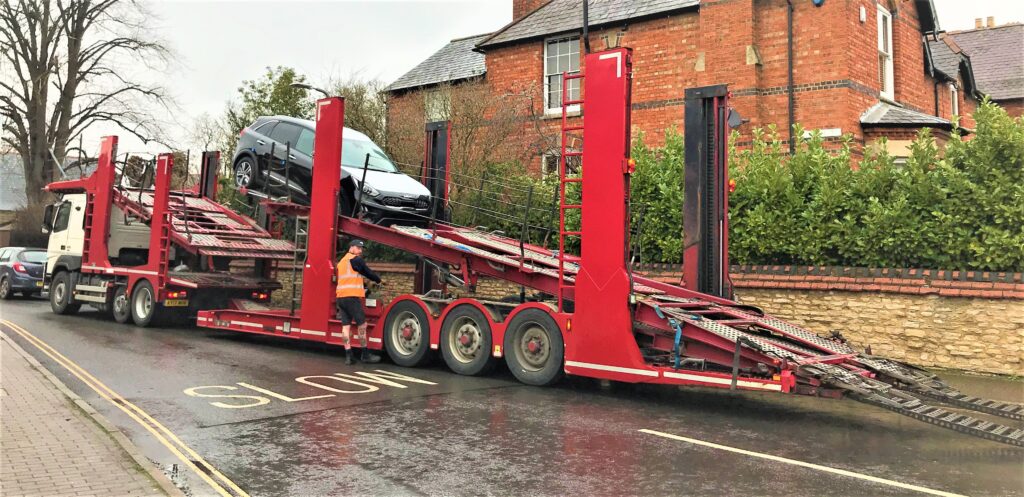
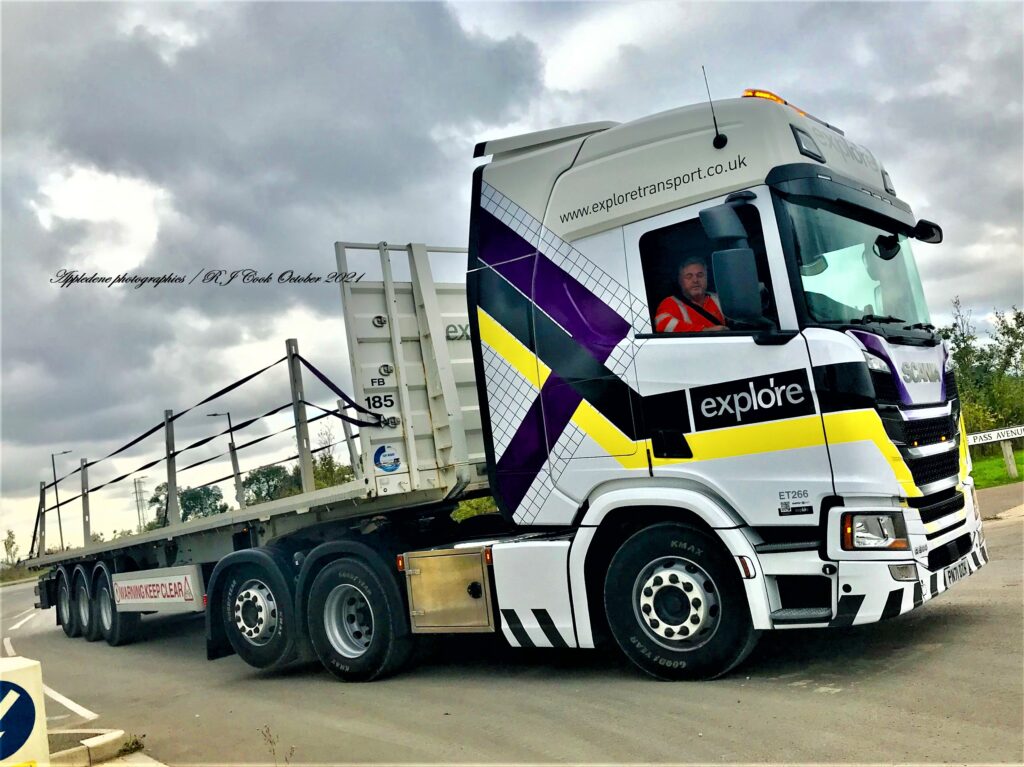
Canada drops vaccine mandate for its truckers after pressure from industry
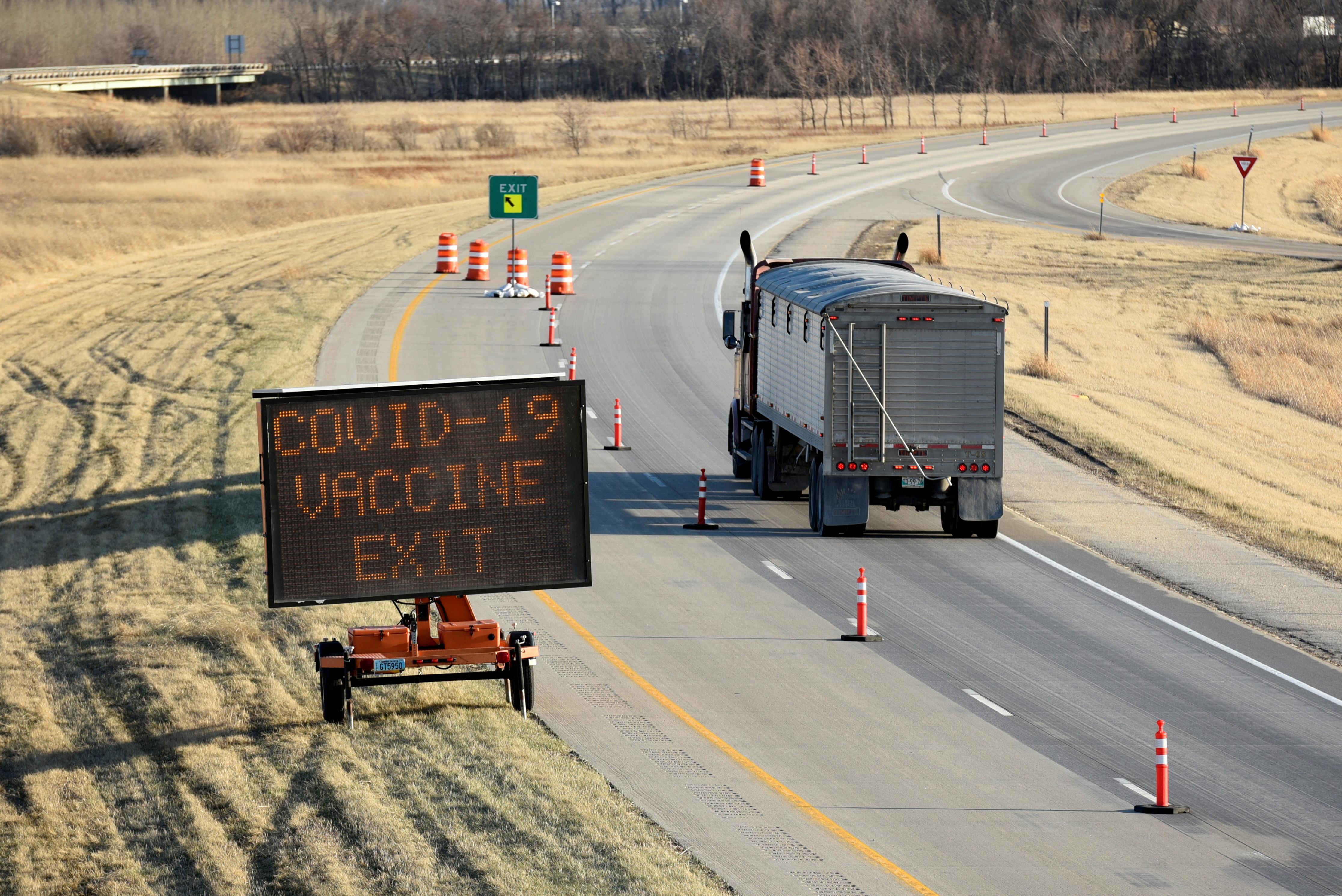
Jan 12 2022 (Reuters) – Canada will allow unvaccinated Canadian truckers to cross in from the United States, reversing a decision requiring all truckers to be inoculated against the coronavirus, Canada’s border agency said on Wednesday.
Canadian Prime Minister Justin Trudeau had faced pressure from the main opposition party and trucking lobby to drop the vaccine mandate for truckers, due to come into force on Saturday, saying it could result in driver shortages, disrupt trade and drive up inflation.
The Canada Border Services Agency (CBSA) said that unvaccinated, or partially vaccinated Canadian truck drivers arriving at the U.S.-Canada border will remain exempt from pre-arrival, arrival and post-arrival testing and quarantine requirements.
However, truckers from the United States will still need to be vaccinated or they will be turned back at the border from Jan. 15, a CBSA spokesperson said.
A Canadian government source said the decision was taken to ensure smooth supply chains.
Trudeau’s Liberal government had set the Saturday deadline requiring all truckers entering from the United States to show proof of vaccination as part of its fight against COVID-19.
With more than two-thirds of the C$650 billion ($511 billion) in goods traded annually between Canada and the United States travelling on roads, the trucking industry is key.
The Canadian Trucking Alliance (CTA) had estimated the government mandate could force some 16,000 cross-border drivers – 10 % of them – off the roads.
Read More Canada drops vaccine mandate for its truckers after pressure from industry | Reuters
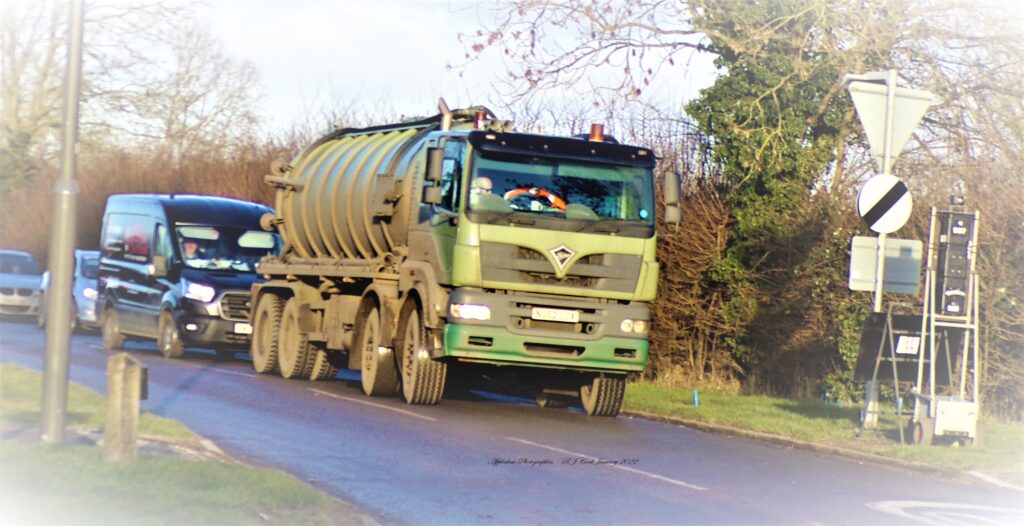
Image Appledene Photographics / R J Cook
Foden Trucks was a British truck and bus manufacturing company, which had its origins in Elworth near Sandbach in 1856. Paccar acquired the company in 1980, and ceased to use the marque name in 2006.
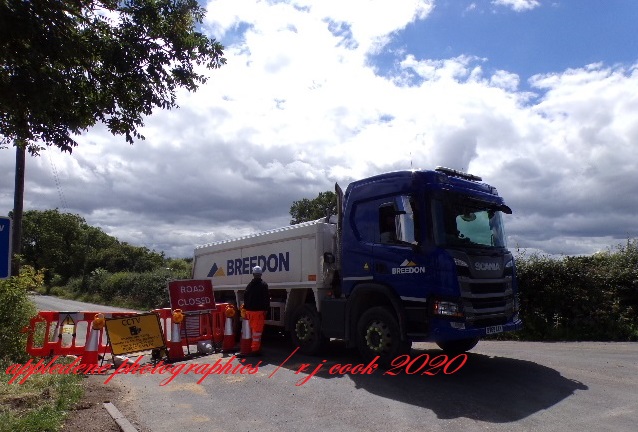
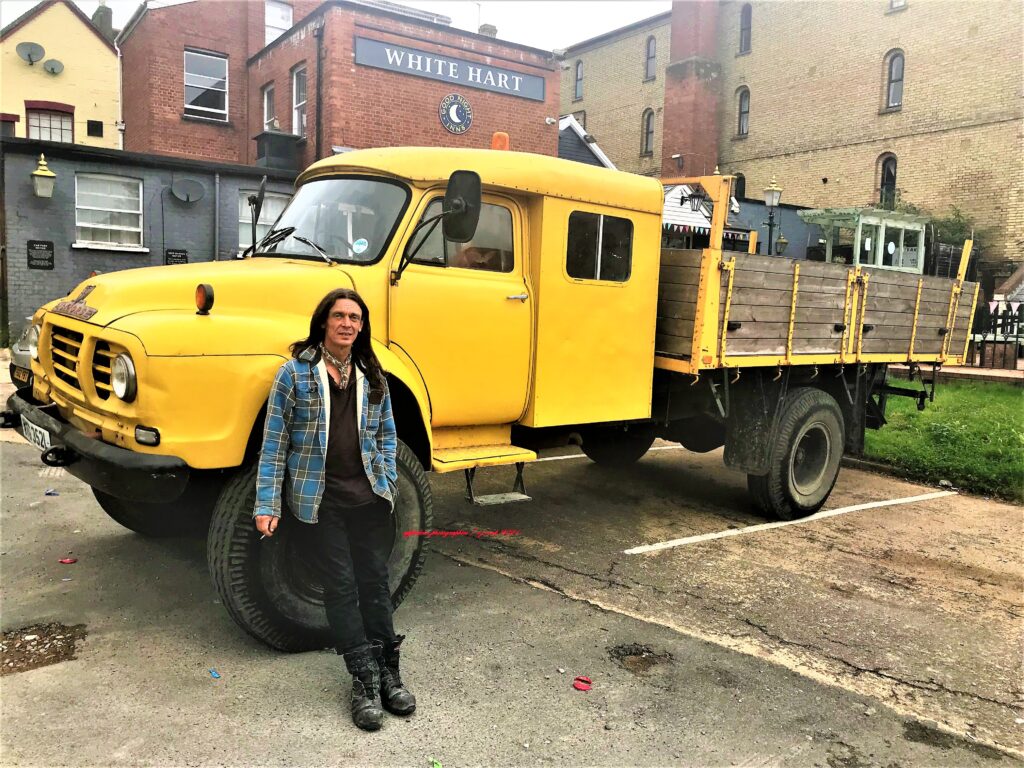

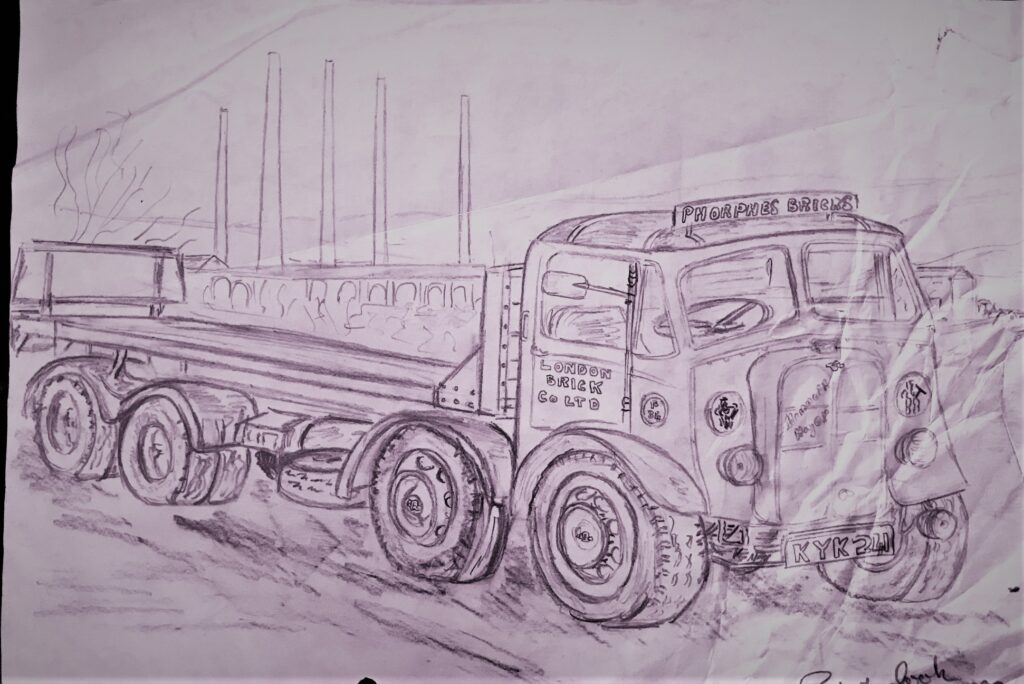
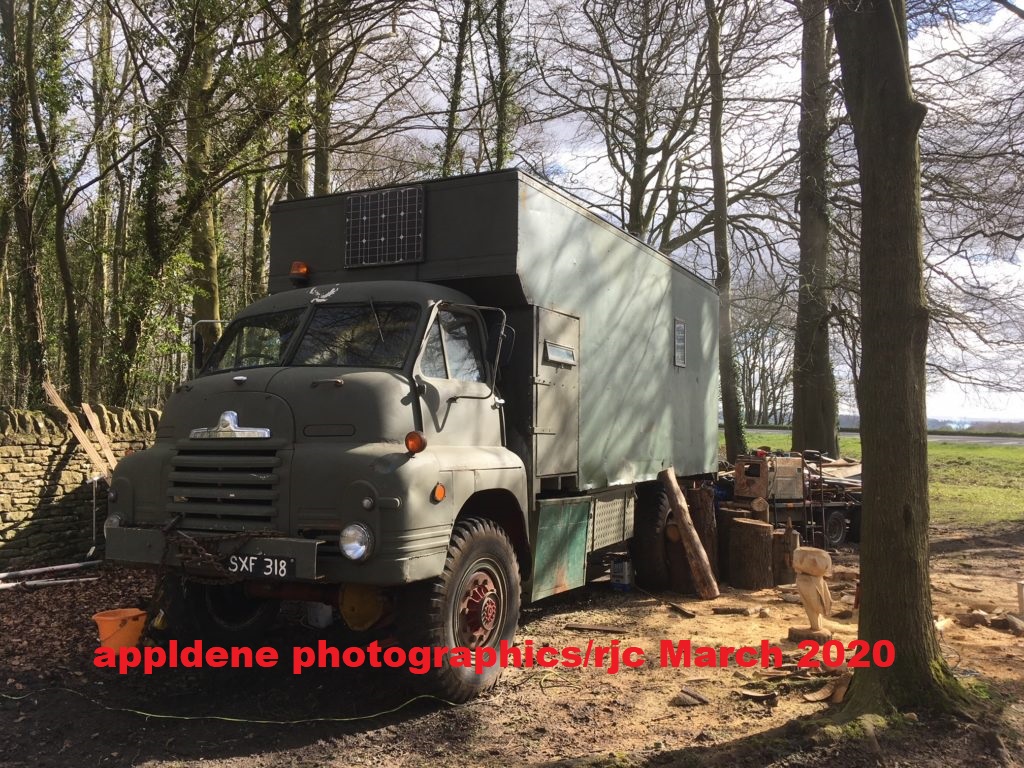
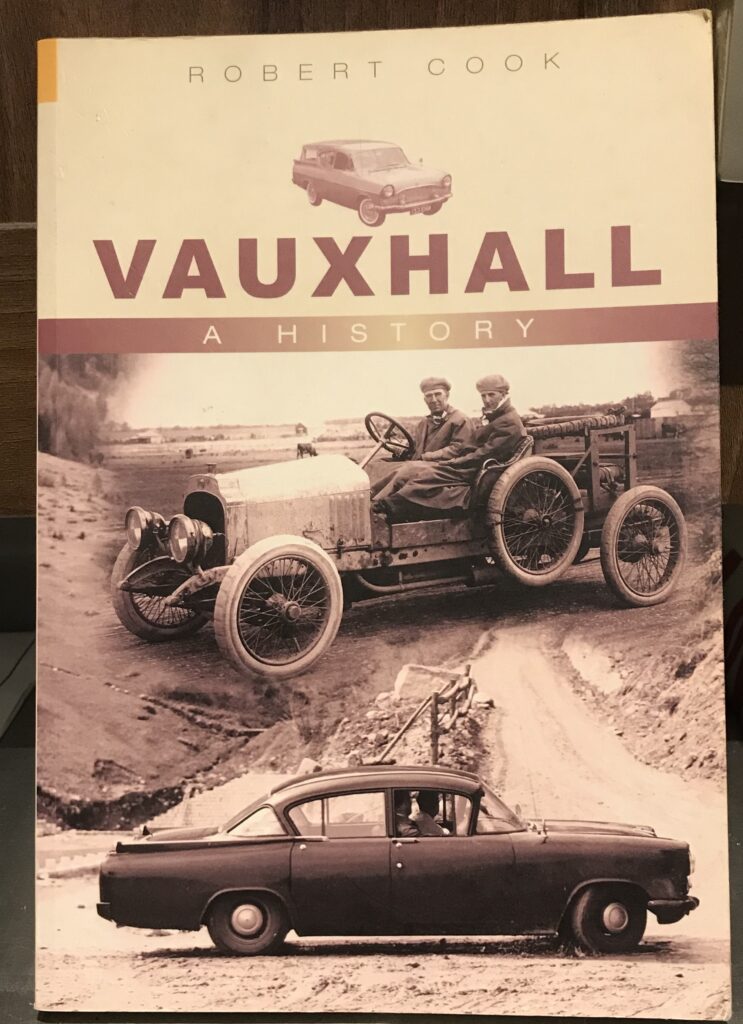
EWR March 26th 2021
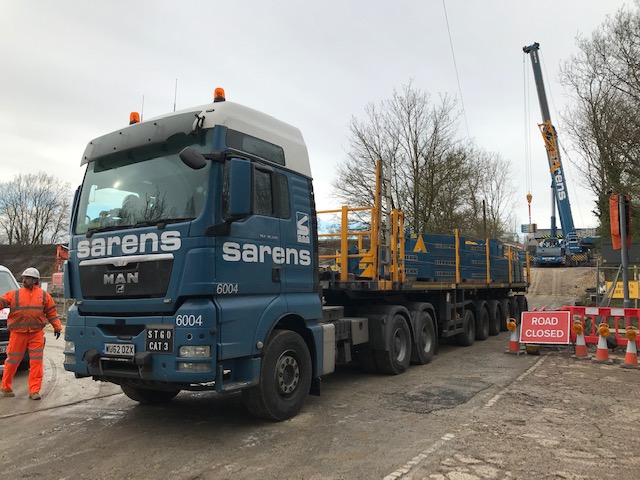
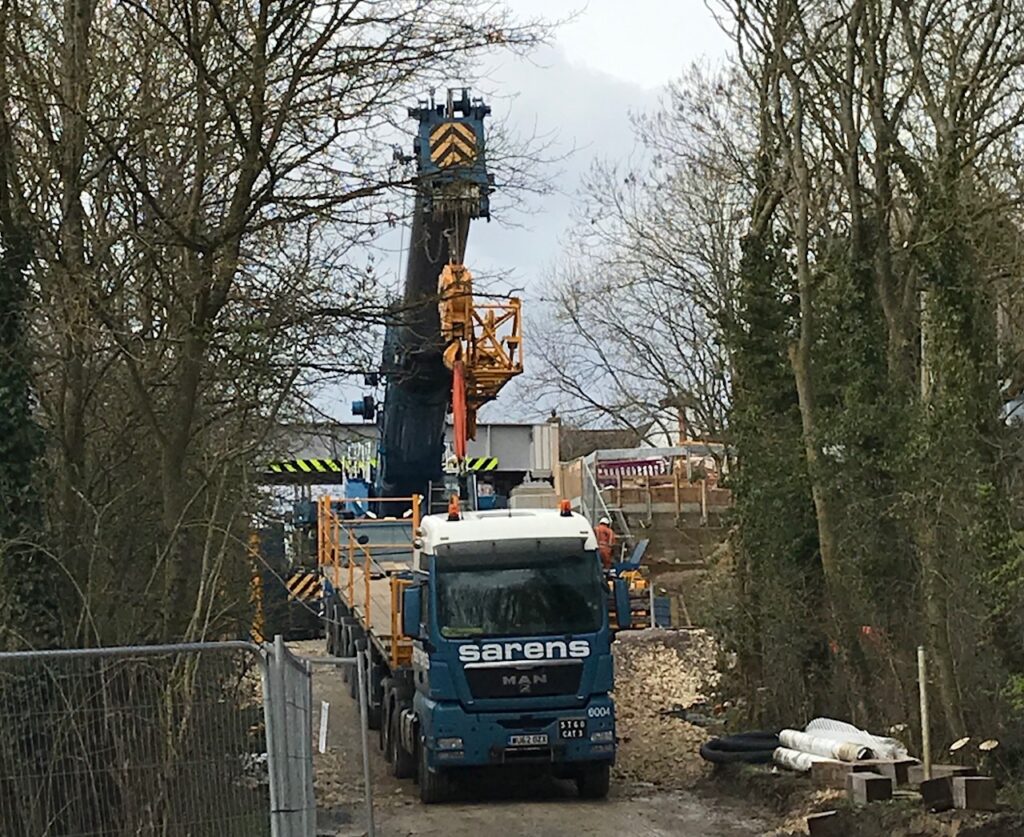
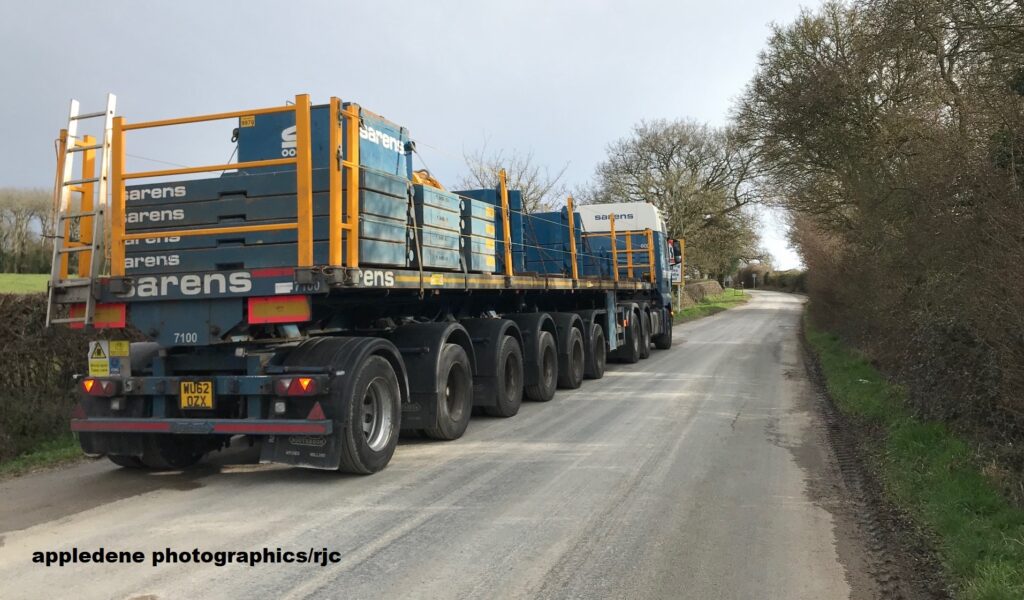
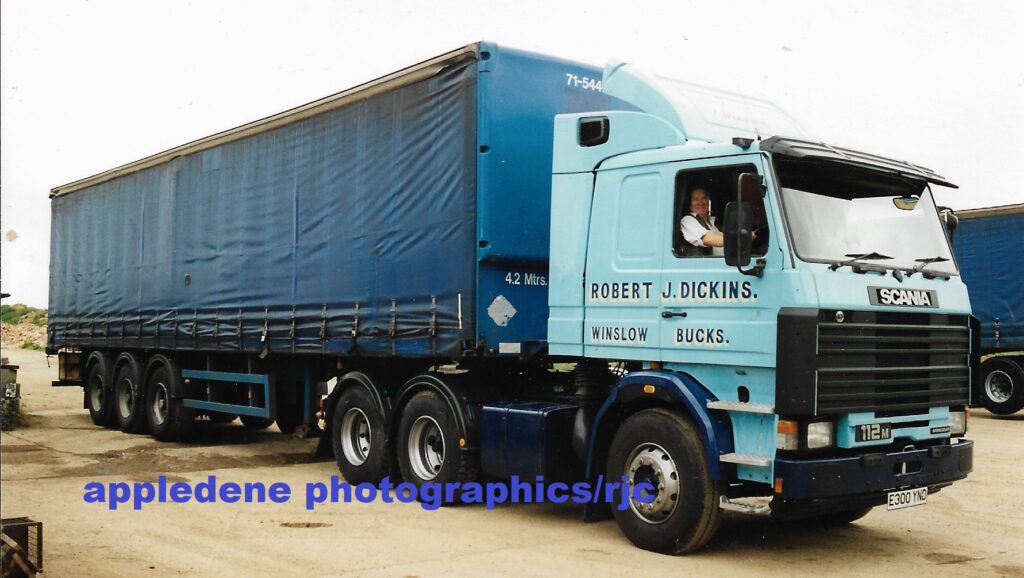
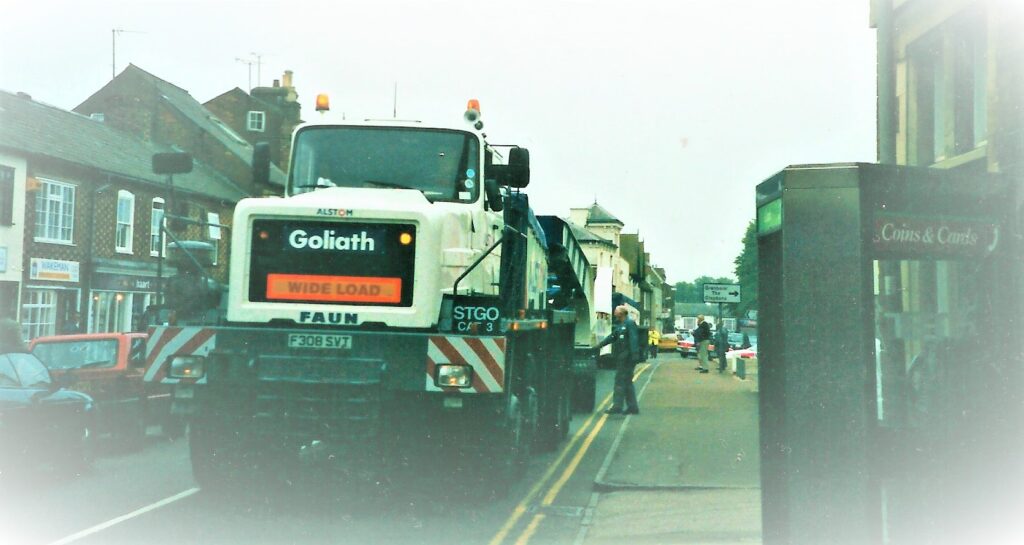
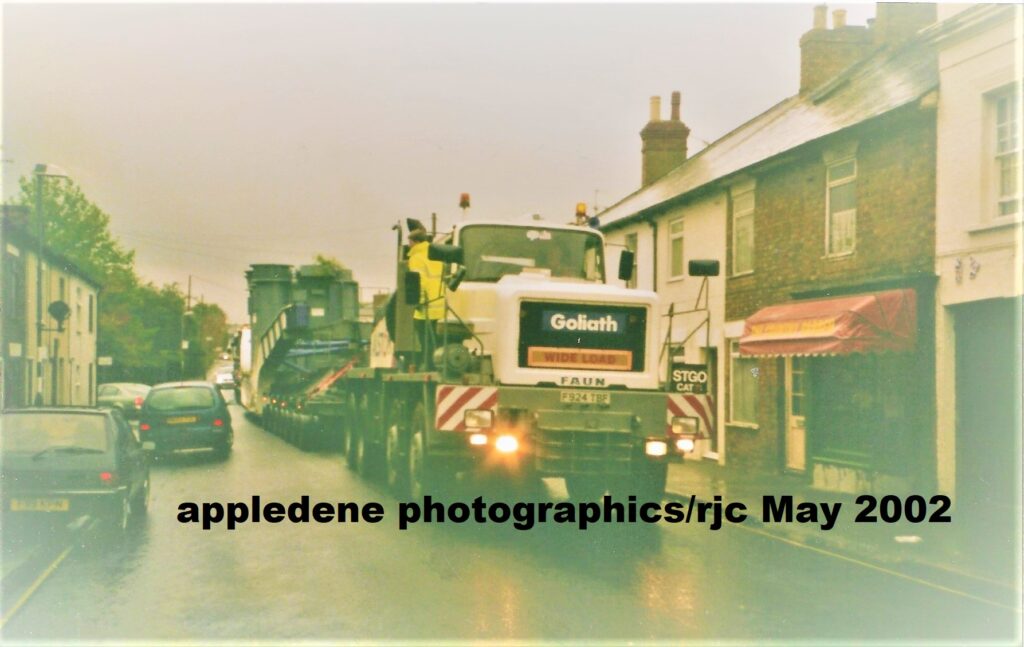
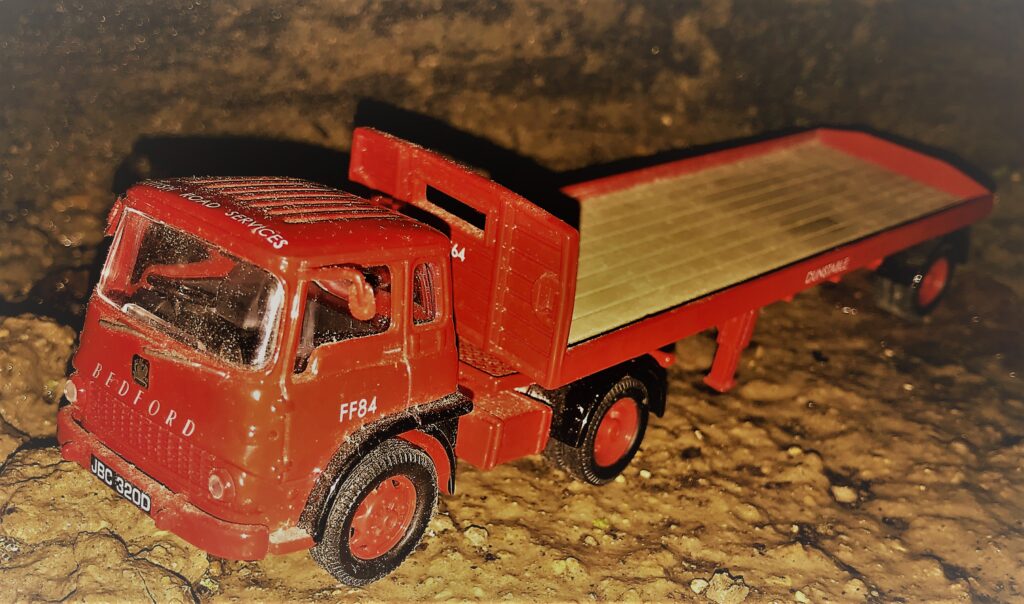
Atkinson Posted January 9th 2021
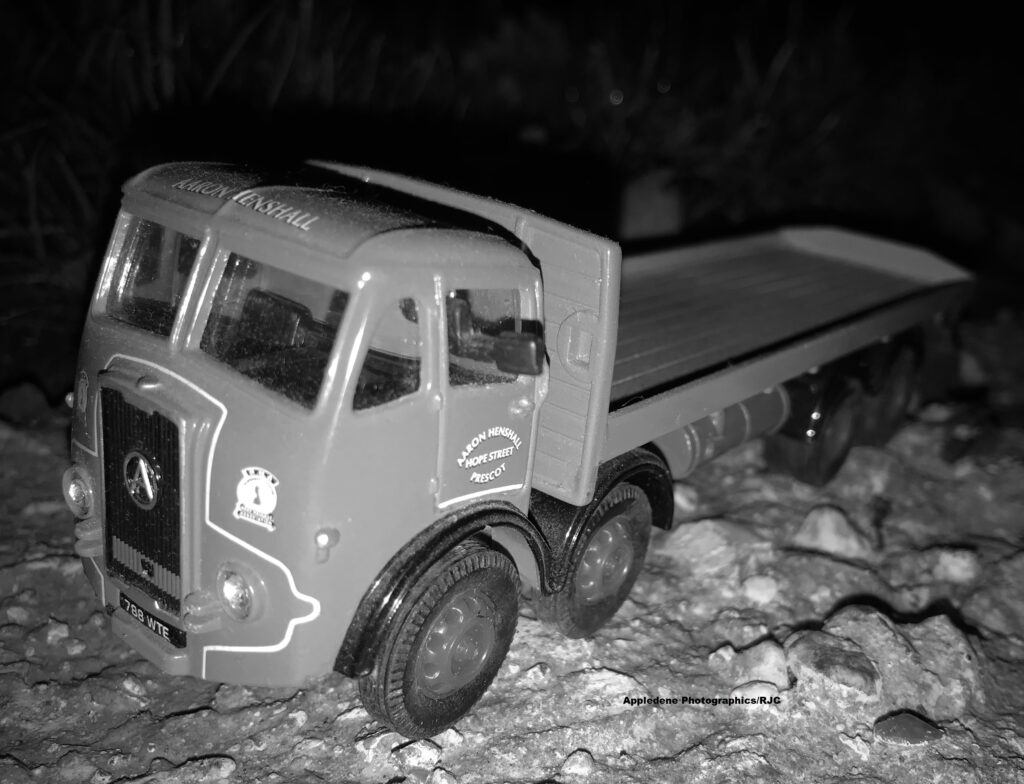
Atkinson & Co. was founded in the Frenchwood district of Preston, the cotton town and administrative capital of Lancashire, by two of five brothers, Edward Atkinson (1880–1932) and Henry Birch Atkinson (1882–1921) with assistance from their brother-in-law George Hunt (1870–1950). The real and effective beginning of the company was in 1907, when the partners decided to capitalise on the need for local engineers to make temporary or permanent repairs to the increasing number of ‘pullcars’ and private motor vehicles on the road. By 1912, the organisation had moved to premises in Kendal Street and the number of employees had grown to twenty. In the same year a second, smaller repair centre was opened in Freemason’s Row, Liverpool, to cater for the enormous volume of steam traffic using the docks. Very soon the company made something of a name for itself in the north of England as quality repairers, and the growing number of operators brought new business from far and wide.
Seddon Atkinson Vehicles Limited, a manufacturer of large goods vehicles based in Oldham, Greater Manchester, England, was formed after the acquisition in 1970 of Atkinson Vehicles Limited of Preston by Seddon Diesel Vehicles Limited of Oldham. In 1974, the firm was acquired by International Harvester,[1] which sold it in March 1984 to the Spanish group Enasa which made it a subsidiary of Pegaso. In 1990, it became part of Iveco which used the brand for various types of specialised vehicles in the United Kingdom. The range of models produced included EuroMover, Pacer and Strato, which are aimed at refuse collection, recycling and construction operators.
Iveco announced its decision to manufacture Seddon Atkinsons in Spain in 2005, and shortly afterwards the brand name was incorporated into the mainstream Iveco catalogue. The Oldham manufacturing facilities were shut down in 2004, and the offices were closed at the end of 2006
Comment The closest I came to the inside of an Atkinson was riding as passenger in a Rolls Royce powered Class One, owned by English China Clay in 1974. It was beautiful, but the company went the way of much worthwhile British Industry in the money grabbing Thatcher era. R.J.C
Thornycroft Antar Posted January 3rd 2020
The Mighty Antar was a heavy-duty 6×4 tractor unit built by Thornycroft from the late 1940s onwards. For some decades it was the standard tank transporter of the British Army and was also used by other nations. WikipediaEngine: Rover Meteorite Mk 204; 1,099 cu in (18.0 L) petrol V8; 260 hp (190 kW)In service: 1951–1984Produced: 1951-1964Maximum speed: 28 mph (45 km/h)Length: 332 in (843 cm)Height: 123 in (312 cm)Width: 111 in (282 cm)
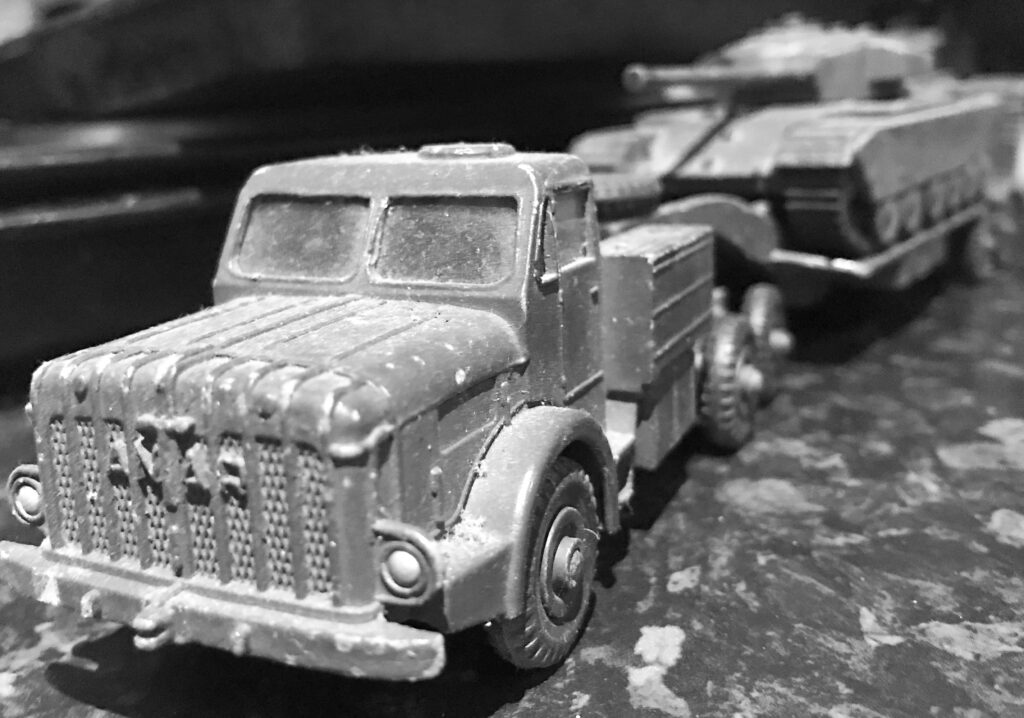
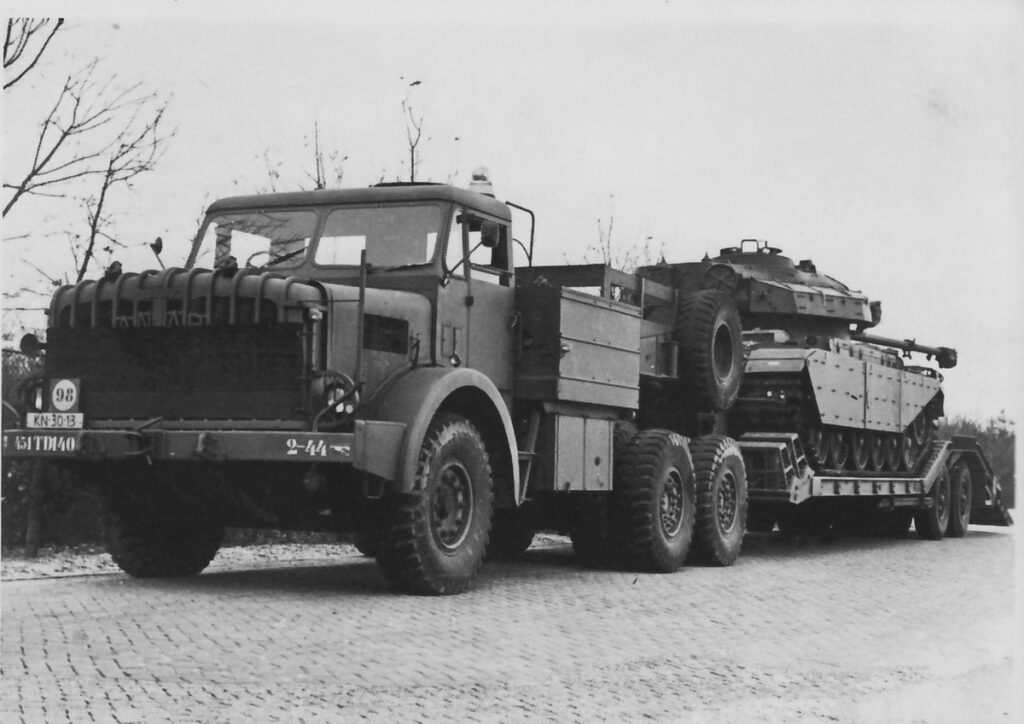

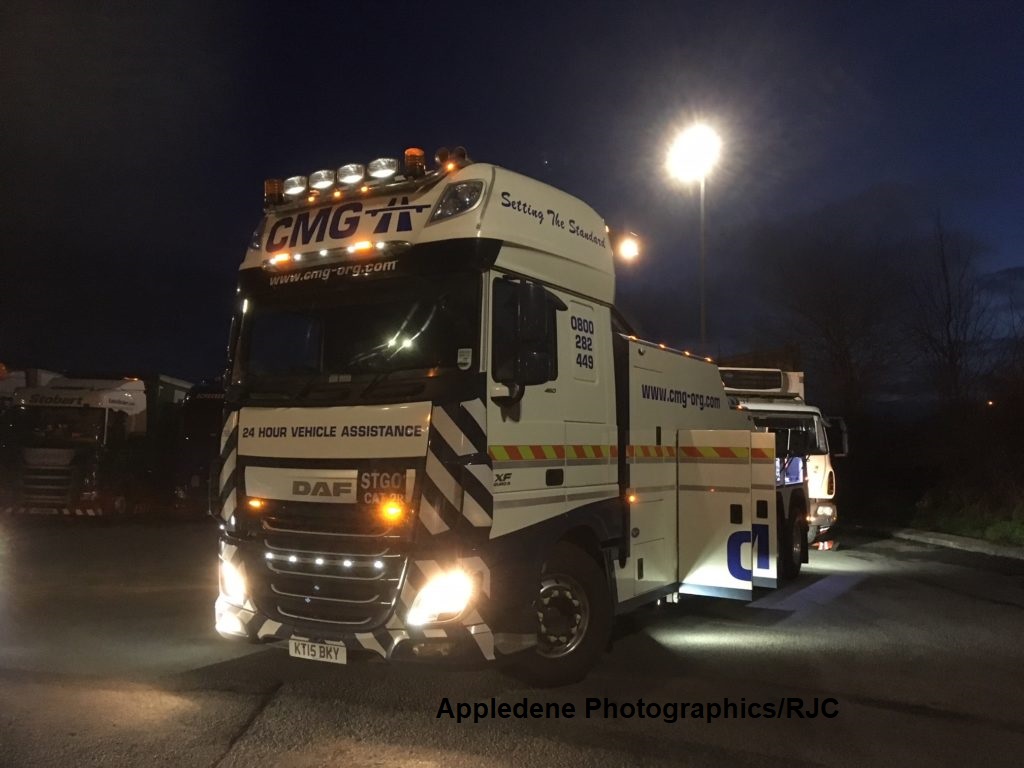
I photographed this mighty recovery truck in Northampton services , around 2 years ago, after a 7 hour wait for recovery. I had done all my deliveries and was on my way back to depot with a Tesco collection from Daventry when the turbo blew and the belt broke.
I admire the ingenuity, skill, competence and sometimes sheer bravery of recovery men. They are out on call in all weathers, sleeping in the truck. I asked one recovery chap what made a good recovery man. He replied, grimly, ‘Having half your brain removed.’
On another occasion, I broke down in Salisbury around 3 in the morning ( 0300 hours ) on a very cold night, My clutch had gone. Fully loaded, fridge off, I waited several hours for the fitter to tell me the obvious.
Many hours later, the breakdown came. I asked him what was his biggest recovery. He said, a showmans rig, comprising a Class 1 with 2 additional trailers. I think he said it was well over 150 feet long, counting his truck. He was recovering it for one VOSA area, then pulled up and fined over £7,000 by another for being over length. The recovery man laughed, telling him he didn’t care because the other VOSA region would have to pay. Good old British bureaucracy and red tape – no one does it better.
R.J Cook.
Image Appledene Photographics/RJC.
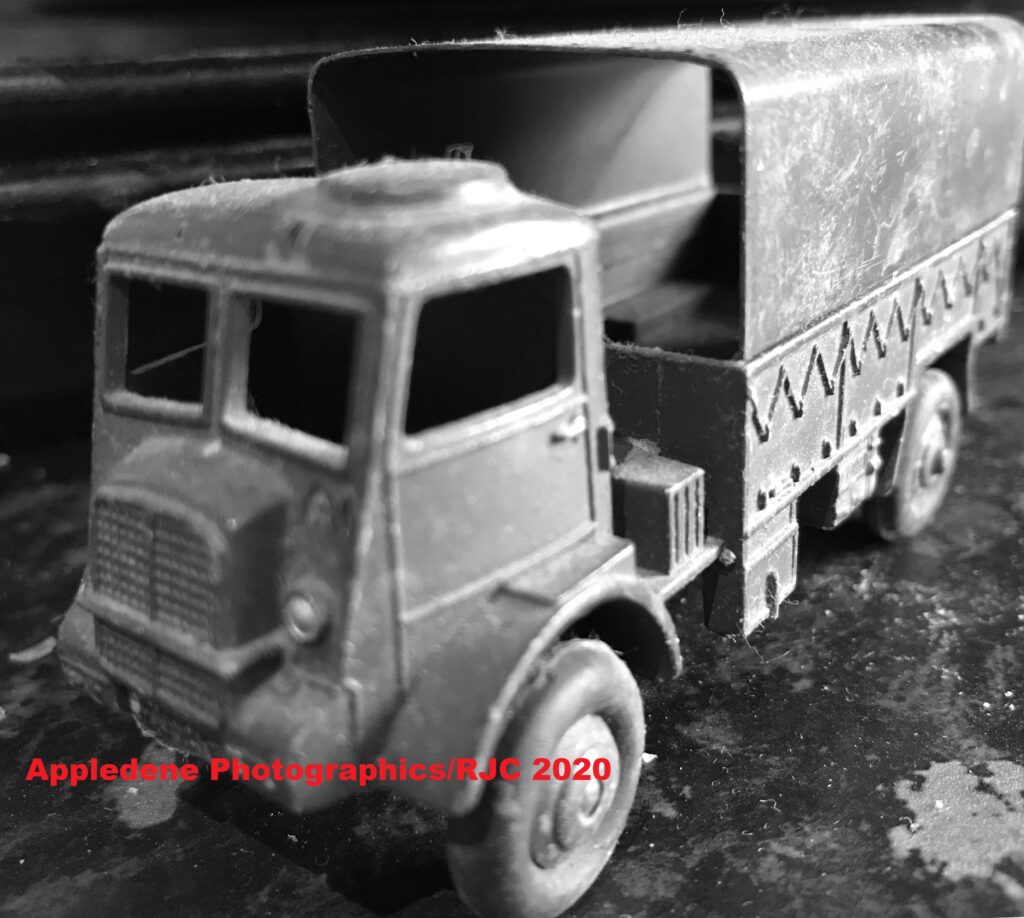
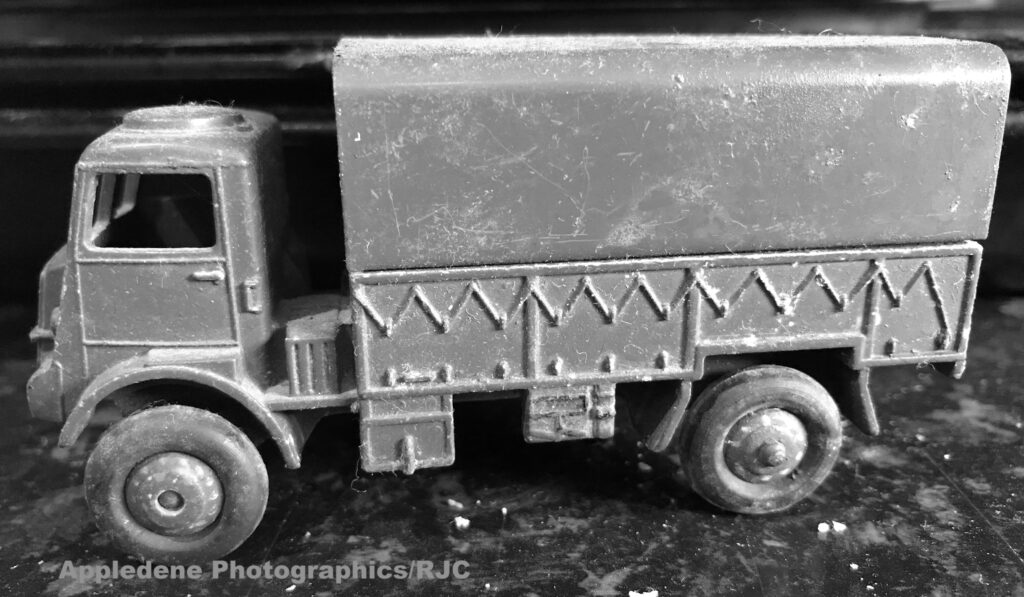
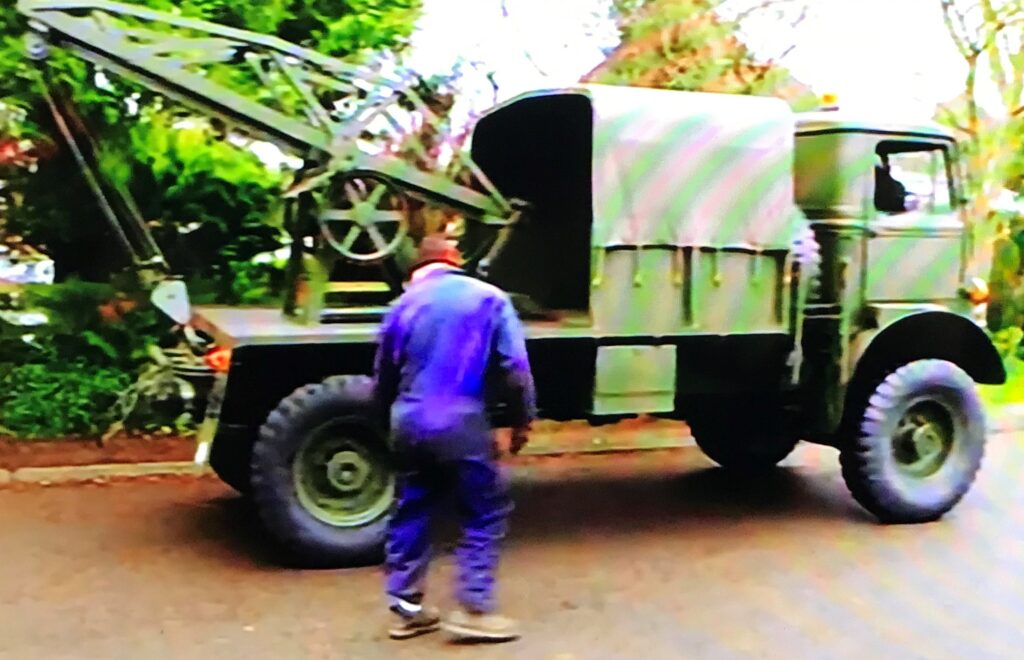

by Robert Cook.
Austin » K9
(1952 – 1955)
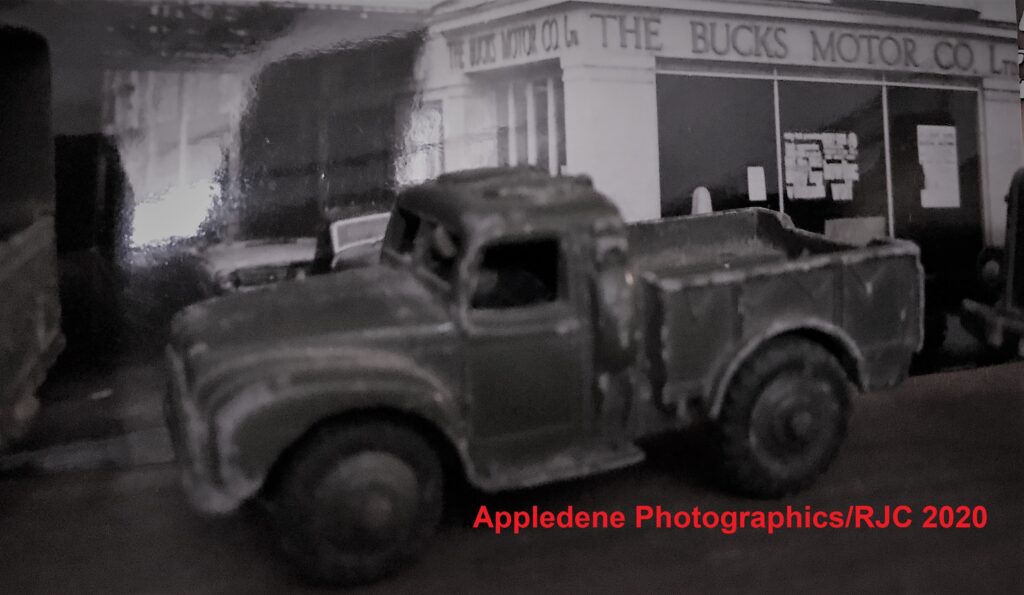
The first military K9 was introduced in 1952. It was derived from the civilian Loadstar range but was modified to make it more suitable for military service, with increased track and ground clearance and all-wheel drive. Designated as the FV16000 series the 4×4 K9 was rated at a very conservative 1 ton and the chassis was adapted for use as a cargo vehicle, ambulance, water tanker and the most numerous was the wireless body.
The Services model saw duty with the Army and RAF from 1951 until as late as 1980 when some of the ‘signals vans’ were still in the hands of the ‘Territorials’, and others were in storage depots. None were bought by the Royal Navy and there is no evidence any were even used by the Senior Service. K9 was equipped with the familiar petrol, overhead valve, 3,995 cc six cylinder developing 92 bhp at 3000 revs. But to create the revised model, rifle clips, a gun ring in the roof, and larger tyres (9.00 x 20) – single all round – were fitted. There was a transfer box to take the drive to the front axle, but even so, the off-road capability was very limited.
Over the years various other modifications took place. These included stoplights, and a convoy lamp and plate. Then came manually raised indicator arms and ‘NATO’ trailer socket, while some ‘K9s’ used by the BAOR (British Army of the Rhine) got electrically operated trafficators. RAF vehicles differed from their sisters in having no convoy light, a civilian pattern number plate lamp, stoplights from new and semaphore indicators in the panel behind the cab doors.
Three types of cab appeared, the differences being detail changes to the scuttle (no waist level louvers on early examples, for instance), floor and rear panels. Some ‘K9s’ were supplied as a cab and bare chassis to be fitted with van bodies or a water tank built by outside coachbuilders. Even the standard bodies though displayed immense variety. The most basic ‘K9’ is probably the Cargo FV 16001 which was designed to carry a section of soldiers and their kit. Cargo/FFW FV 16002 is the somewhat lengthy code which described the standard ‘K9’ truck when ‘fitted for wireless’ (FFW).
But in 1955 there were developments on the communications front when a new range of radio stations called ‘Larkspur’ was introduced. This led to the FFR (fitted for radio) ‘K9’ with a mast on the body side, brackets for the aerial tuning unit (left front wing top) and various other supports and leads. These were officially described as Radio Station Van FV 16003 and also as ‘Wireless Light’. There was also Radio Repair Van FV 16004, which was also the same as 16003 only fitted out for the roles described. The ambulance version called FV 16005. The 200 gallon water tanker was coded FV 16009 or 16008 (for RAF) and had a proprietary body built in Durham. Other versions were FV 16006 signal, FV 16010 welding, and FV 16011 radar calibration equipment.
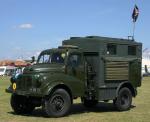
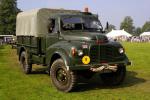
Edwin Richard Foden Posted December 8th 2020
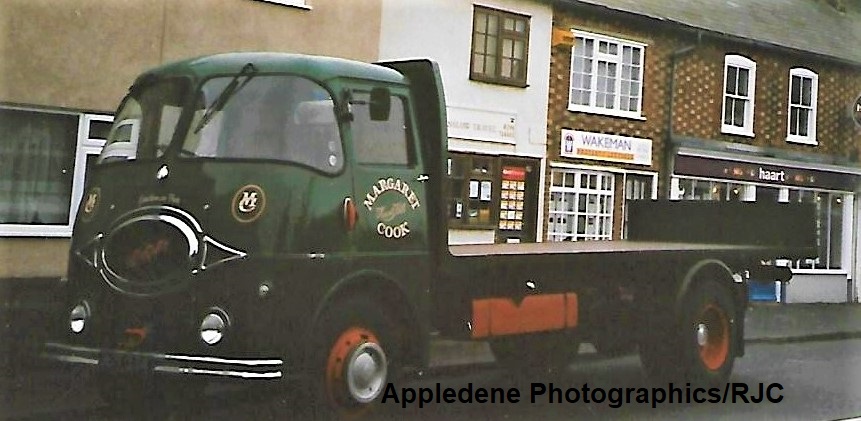
At the beginning of the 1930s, Britain’s industry was struggling to survive the worst recession in many years and unemployment exceeded two million. At this time insurers were becoming increasingly reluctant to underwrite steam boilers. As a result, Edwin believed the future of the lorry building industry lay in diesel engine power. The Foden boardroom did not agree, and consequently he resigned along with his son Dennis.
With the help of his son Dennis and two former colleagues, including Ernest Sherratt who became Chief Engineer, Edwin worked to build the first ERF diesel lorry in 1933, and gave the first chassis the number 63 which was Edwin’s age. From the beginning, the company bought components only from other suppliers rather than manufacture itself, including engines from Gardner, gearboxes from David Brown and axles from Kirkstall Forge Engineering. This concept would serve ERF well throughout its existence.
A new cab was styled by Sandbach coachbuilder John Henry Jennings, who also provided initial factory space to assemble the new lorry. Based in Sandbach, the company made its own chassis and cab. The cab structure was made in Northampton at Air Flow Streamlines and fitted out by ERF in Sandbach. The engines from Gardner, but later also Cummins, Rolls Royce, Perkins, Detroit Diesel and Caterpillar.[1]
ERFs used to be marketed under the Western Star badge in some countries such as Australia.[2] It also built a specialist fire engine chassis, with a body built on by in-house company JH Jennings, later Cheshire Fire Engineering. However, when recession came in the beginning of the 1980s, and production fell from a total output of 4,000 chassis per annum, CFE was sold to management to eventually become Saxon Sanbec.
ERF was never a major manufacturer; as an example its domestic sales total reached only 1,083 trucks in 1981.[3] The company was bought by Canadian truck maker Western Star in June 1996.[4] However, after Paccar‘s purchase of Foden, DAF Trucks and Leyland Trucks competitive pressure increased, and after Western Star was approached by Freightliner Trucks, the decision was made to sell ERF.
Purchase by MAN
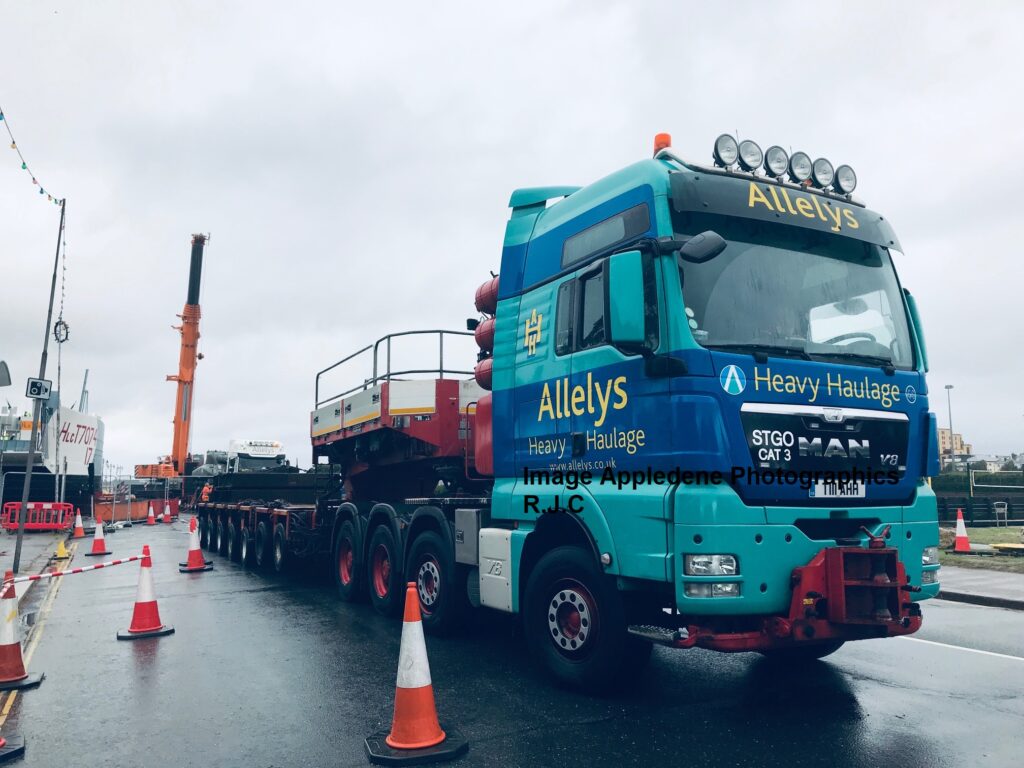
Image Appledene Photographics/RJC
In March 2000, ERF became part of MAN, with production moving to a new factory in Middlewich.[5] It was later discovered that fraud had occurred at ERF, and its financial position had been incorrectly stated, with MAN winning a legal case against Freightliner.[6][7] Freightliner in turn tried to sue Western Star and ERF’s former auditors Ernst & Young, but failed on the grounds of corporate negligence.[8] Source Wikipedia
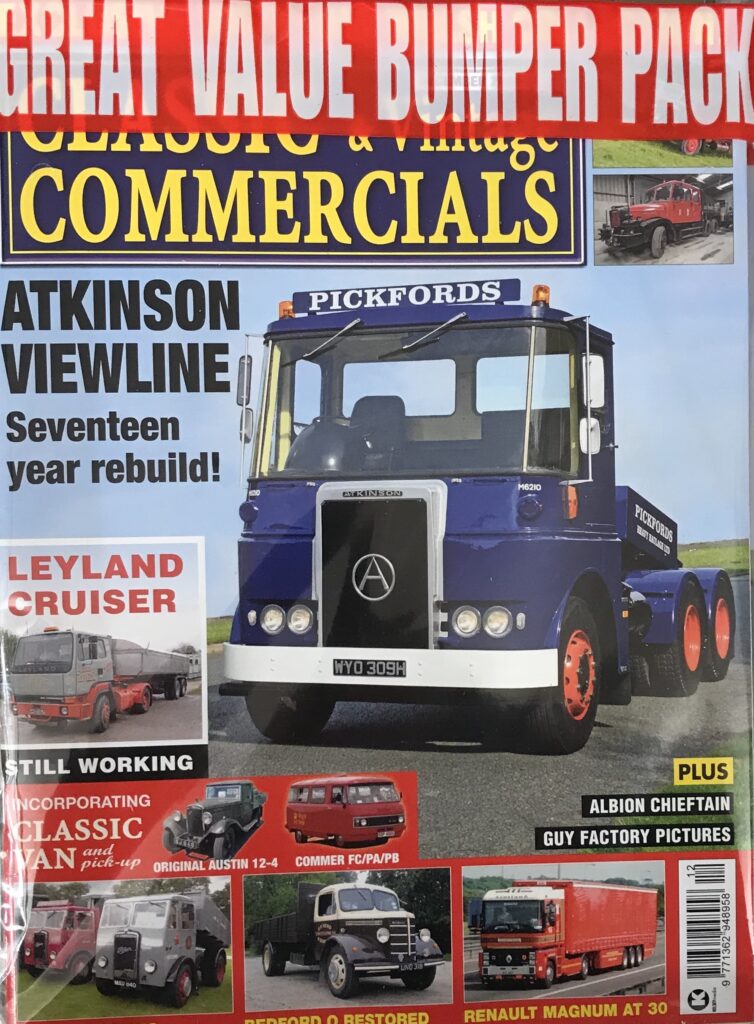
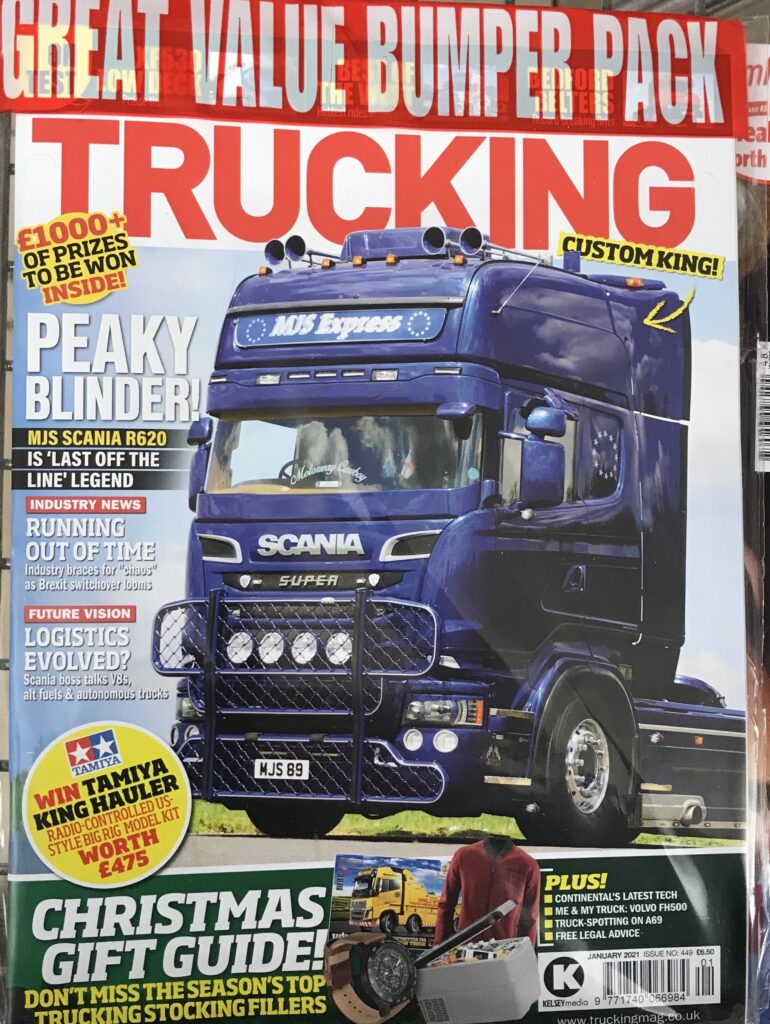
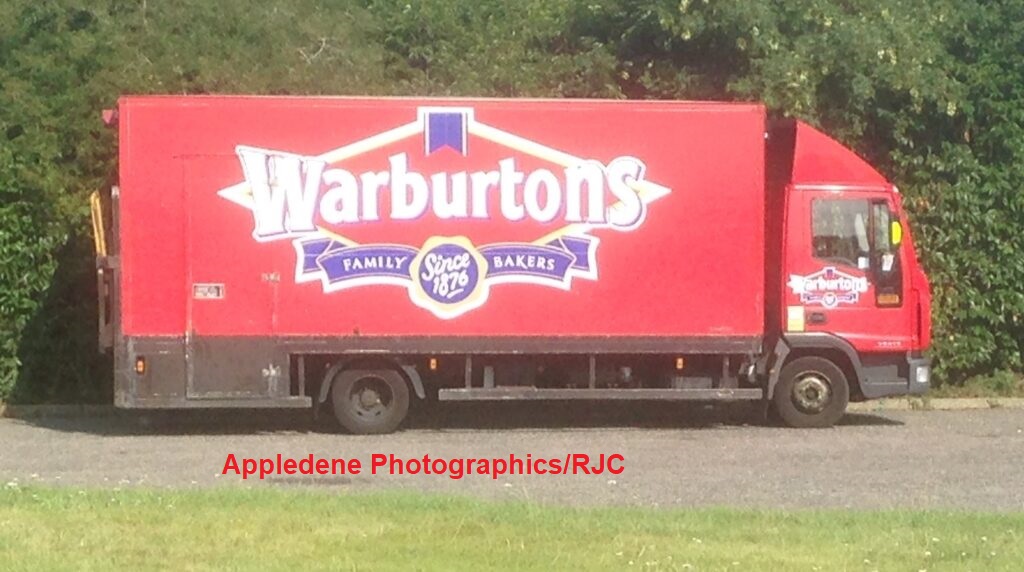
Having been demonised by malicious police records in 2008, I was forced to take whatever job was offered. Thus I had the pleasure of driving this heavily loaded Iveco bread lorry around Northampton and its extremities. Iveco bought Ford’s truck division, this vehicle originally the Ford Cargo design. I did a Class One HGV course back in the 1980s, with a Ford Cargo 6 speed unit and flat bed single axle trailer. I didn’t like that vehicle either, but their cars and farm tractors have always been fun, with excellent well matched engines and gear boxes.
Image Appledene Photographics/RJC
Hell Drivers, Film 1957
I have watched Hell Drivers many times, first was back around 1960. I was still a child but loved trucks, having grown up with them because of my father’s job and living in a little house by the side of a busy main road. So when it cropped up on the cinema channel yesterday, I watched it again.
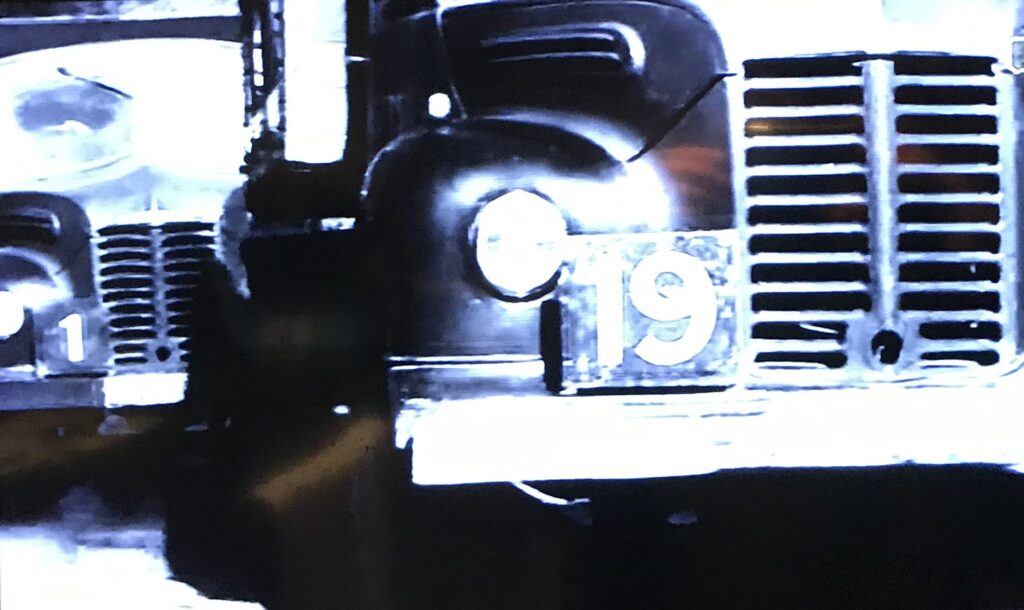
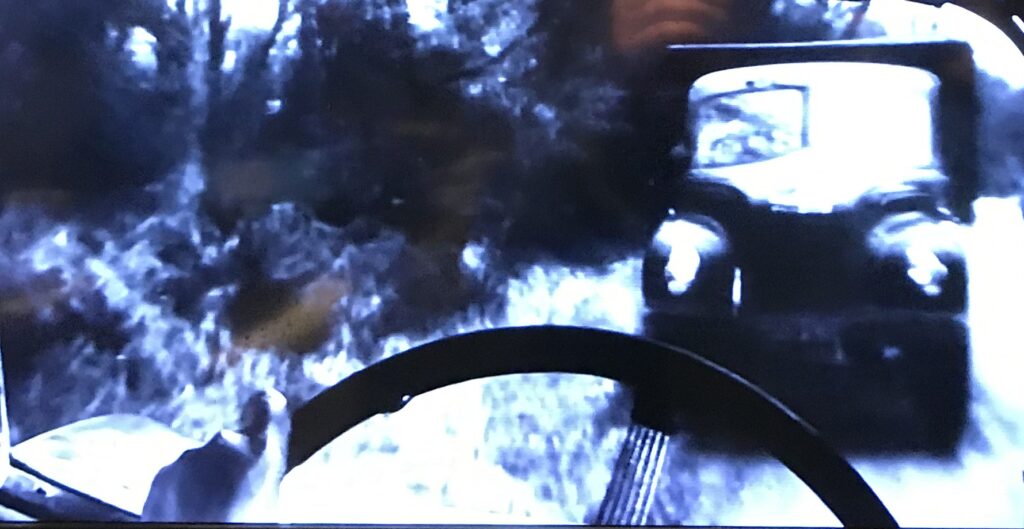
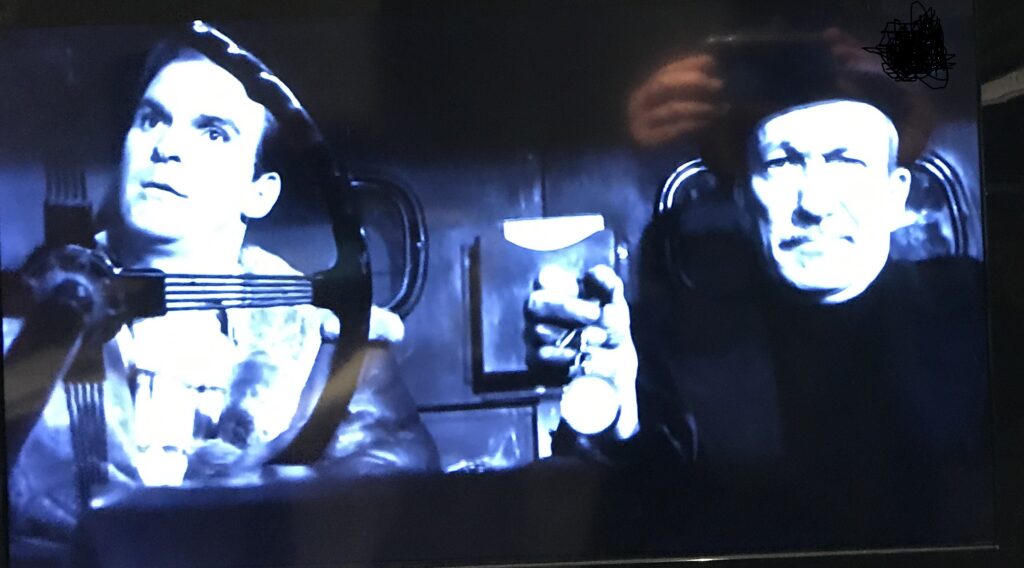
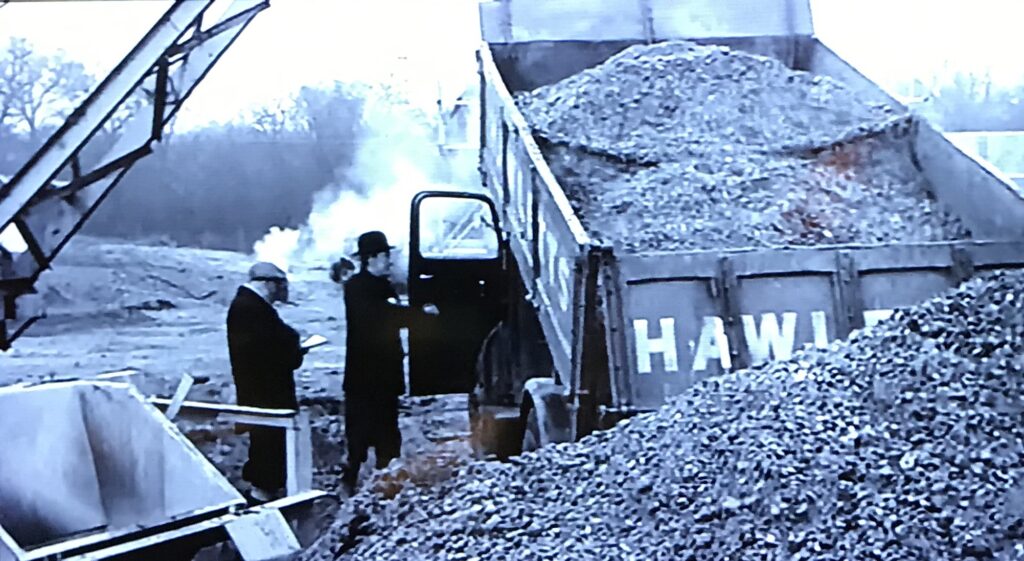
Even the recently demised Sean Connery, whose varied pre acting work included truck driving, had a role in this movie about drivers cutting one another up on piece work loads of ballast. The closest I came to being a hell driver was working for City Link where we had a 3 minute delivery window – and at least 100 drops over a wide area.
When I quit driving their vans to go back on the night shift for five years, they were so short of drivers that I was frequently asked to take a van load of parcels out the next morning. Regards tippers, the only ones I experienced were the Bedford J types during a brief period working for Bucks County Council Highways Department. I recall the need to double de clutch on first gear. They were rated Class 3 in those days, used as snow ploughs, spreading chippings while reversing with the door open, and gritting – there were special atatchments.
Sadly, I was young and love sick so had no mind to take photos. I disappointed my boss, who had high hopes that I might follow in my Great Uncle Harry , the County Highways Engineers footsteps. So off I went to Portsmouth and a very boring job in a tax office. R.J Cook

- The 800 series diesel marked a low point in British Leyland and was nothing other than a fatal disaster costing way more than just hard cash. AEC’s public reputation of a once trusted and respected company was destroyed by nothing more than a British Leyland ego trip.
Essay : Not their finest hour – AEC–Leyland 740/800 series … www.aronline.co.uk/facts-and-figures/not-their-finest-hour-aec–leyland-740-800-series-v8-die
- The Restoration of the Movin’ On Truck April 24, 2019 The well-known 1970’s show Movin’ On holds a special place in many hearts. Running from 1974-76, the show featured two gypsy truckers, Sonny Pruitt and Will Chandler, played by Claude Akins and Frank Converse.
The Restoration of the Movin’ On Truck
Associated Equipment Company (AEC)
The Associated Equipment Company was founded in England in 1912 although, it usually traded under the name AEC. Its origins go back to 1855 when the London General Omnibus Company (LGOC) was formed. It however, did not start producing buses for its own use until 1909. In 1912 the LGOC was in turn taken over by the Underground Group which was responsible for most of London’s extensive underground tram operations. As part of that process a separate division was set up for bus manufacturing and this was named Associated Equipment Company (AEC). The advent of WWI saw AEC come under direct control of the British Government who used its assembly lines to mass produce army ‘lorries’ for the war effort. AEC produced 10,000 three and four ton Y models and 1300 buses converted to transport carriers for the Armed Forces during the war. From that point on, AEC became known for both truck and bus production and manufacture of both continued aggressively after the war.
In 1923, the company produced the first of what was considered a civilian goods model. The two ton 201 was powered with a 28 bhp petrol engine. Following this, there was a brief association with Daimler in 1926 which saw the business relocate to a new plant in Southall. London. This dissolved within a couple of years and in 1928 AEC entered into contractual arrangements with both Hardy Rail Motors Ltd and the English version of the Four Wheel Drive Motor Company (FWD) whereby AEC components would be used in all off-road or cross country models produced. Defence contracts and works were still a major part of AECs business in peace time Britain. Many felt a Second World War was imminent and this was the impetus for development of what is Australia’s rarest AEC truck; the 1934 government roadtrain housed at the National Road Transport Hall of Fame in Alice Springs. Magnify
Upon relocation to Southall a new Chief Engineer was appointed. Mr. GJ Rackham, who had previously worked for Leyland Motors, took the business in a new direction of productivity particularly for the export market to other countries of the Commonwealth. From 1929, AEC produced many new models; the names of trucks began with “M” (Majestic, Mammoth, Mercury etc), and those of buses began with “R” (Regent, Regal, Renown). In 1933 AEC was floated as a separate business and the company went public before producing several very unusual products including a low loader type 8×4 rigid called the Crocodile and the 8×8 Overseas Tractor unit based on an earlier design by Hardy Motors Ltd. In .These original “M-models” continued in production until the end of the Second World War when a new range of diesel powered models was introduced. AEC’s first diesel engine, released in 1930, was a six cylinder 8.1 litre rated at 95 bhp. At this time, AEC also took a controlling interest in the UK subsidiary of the USA based Four Wheel Drive Company (FWD) introducing the use of AEC components into that range. These were marketed under the name Hardy to prevent confusion with the USA marquee of the same name.
Commercial production ceased in 1941 following the outbreak of WWII and all efforts were once again put to military needs. During this time AEC produced their 10 ton 4×4 Matador Artillery tractor and a 6×6 version (officially called the Marshall but usually referred to as a 6×6 Matador. The Matador was used extensively during WWII as both a gun tractor and an armoured version as a mobile battle headquarters or command posts. Magnify
At war’s end AEC acquired Crossley and Maudsay and resumed civilian production with the Mammoth Major, Matador and Monarch ranges. AEC changed its name to Associated Commercial Vehicles (ACV) Ltd., although it kept the initials “AEC” on most of its vehicles. ACV then acquired the bodybuilding company, Park Royal Vehicles, which went on to design a new cab for the AEC Mercury in the mid-1950s; this cab eventually appeared on all models across the range during this period. By 1961 AEC had also acquired Transport Equipment (Thornycroft) and effectively removed that name from the marketplace with the exception of the Nubian airport crash tender and the Mighty Antar roadtrain units best known for their work in Australia on the Snowy River Mountains Hydro Electric Scheme. By the end of the 1950s AEC was experiencing rapid expansion introducing the Mk V range and the Mammoth Major 8 many of which were exported to Australia, South Africa, South America and other countries reliant on an efficient road transport industry for their own development.
A new era for AEC was heralded in 1962 when Leyland Motors acquired ACV in 1962 and Leyland cabs were used on most models. Demand for AEC/ Leyland vehicles from around the world continued well into the mid 1960s by which time European and American trucks were also being imported into Australia. By 1968 production of all double decker buses had ceased but the AEC name continued on some trucks and buses up until 1977. In 1979, following nationalisation in 1975 in an attempt to save the ailing organisation, the doors closed permanently on British Leyland’s (as it then had become) Southall plant and all production.
Many AEC models were sent to Australia over the years and for a time the big British built trucks were King of the Road in Australia. Many fine examples of early AEC trucks have been restored by enthusiasts around the country and are on display in museums or private collections. Several buses can be found at the Sydney Bus Museum including a 1963 Routemaster double decker and several Regent Omnibuses dated as early as 1947.Magnify
MAMMOTH
The Mammoth was a 7/8 ton truck with a110 bhp six cylinder overhead valve engine. It went on to have three versions: the Mammoth Minor 6×2, the Mammoth Major 6×4 and the Mammoth Major 8 x4 which could carry a 15 ton payload.
MANDATOR
The AEC Mandator dates from the 1930s and post war production saw it available both as a tray and prime-mover units and was available up until the mid 1970s.
MATADOR
The AEC Matador was originally a 5 ton 4×2 commercial truck made famous for its use in WWII as an artillery tractor with the British Forces where it was given the nickname ‘Mat’. AEC had produced 9,620 of these during the war and adapted them afterwards for civilian use where they initially found popularity as recovery vehicles and in the timber industry. The Matador was distinctive with its flat front and curved cabin roof.
MERCURY
The AEC Mercury was a forward control truck first introduced in 1928. It had a wheelbase of 14ft and carrying capacity of 4 ton. In 1930 it became available with a 4 cylinder 65bhp petrol engine.
MILITANT
The AEC Militant, or “Milly” as it was known, became the replacement for the Matador in 1952 and its production continued in various forms up until the 1970s. The Militant was based on the design of a truck produced by Maudslay in 1930. The Militant was renowned for its good cross-country performance making it ideal for recovery work but because it had no power steering military drivers complained it was difficult to turn the wheel at slow speed and in difficult terrain. Interestingly, this model was also nick-named ‘Knocker’ because of the sound of its slow revving engine. In Australia the Militant was widely used on the Snowy Mountains Hydro Electric Scheme usually fitted with an 11.3 litre diesel engine and 5 speed gearbox with 2 speed transfer case.
MOGUL
The AEC Mogul was also based on the design of an earlier Maudslay model. It was available from the 1960s and was called a “normal control tractor unit”.
MONARCH
AEC Monarch were built from 1931 to 1939 having ceased production at the onset of WWII. Over the years it range varied considerably and it was available well into the 1970s.The Monarch was usually fitted with either a 85bhp four cylinder 5.1 litre diesel engine or a 80bhp four cylinder 5.1 litre petrol engine.
At Work in Australia


Collection

















Trucks Restored in Australia









Featured Story – The AEC 8×8 Government Roadtrain
Download The AEC 8X8 Government Roadtrain.pdf Featured Story.




The AEC Mammoth was introduced in 1930, being largest truck in the AEC range and the first to be available as a cabover. It was originally a 7/8 ton 4×2 lorry with a six-cylinder overhead valve engine developing 110 bhp (82 kW) on a wheelbase of 16 ft 7 in. A 6×4 variant was the “Mammoth Major”. From 1934 a distinction was made between the lighter Mammoth Minor, and the heavier Mammoth Major 6 (6×4) and Mammoth Major 8 (8×2 or 8×4), which appeared in 1934. The Mammoth Major Mk II was introduced in 1935; the eight-wheeler could carry 15-ton loads. It remained in production until 1948 when it was superseded by the Mk III, which was mechanically similar, but had the Park Royal cab. Subsequent Mammoth Majors featured the Mk V cab, and finally the tilting Ergomatic cab. The original 4×2 Mammoth and lightweight Mammoth Minor were relatively short-lived models, but both names were later re-used.
- Mammoth, model 667 (1930–34) – 4×2 cabover
- Mammoth Major 6 Mk.I/II, models 668 (1930–35), 366/O366 (1935–48) – 6×4 cabover (Mk.II from 1934)
- Mammoth Major 6 Mk.III, models 3671/3672/3673 (1948–60) – 6×4 cabover (‘tin front’ cab from 1955)
- Mammoth Major 6 Mk.V, models G6 (1959–66) – 6×4 cabover
- Mammoth Major 6, model TG6R (1965–78) – 6×4 cabover (Ergomatic tilting cab)
- Mammoth Major 8 Mk.II, models 680 (1934–35), 386/O386 (1935–48) – 8×4 cabover
- Mammoth Major 8 Mk.III, models 3871/3872/3873/3881/3882 (1948–61)- 8×4 cabover (‘tin front’ cab from 1955)
- Mammoth Major 8 Mk.V, model G8 (1959–66) – 8×4 cabover,
- Mammoth Major 8, model TG8R (1966–78) – 8×4 cabover (Ergomatic tilting cab)
- Mammoth Minor, model 366L (1936–41) – lightweight 6×2 cabover
- Mammoth Minor, model TG6RF (1965–67) – twin-steer (“Chinese six”) 6×2 cabover (Ergomatic tilting cab)
Normal control variants of the Mammoth family were also available, although much less common that the cabovers:
- Mammoth Major 6 Mk.I/II, model 266 (1930–36) and 366 (1936–48) – 6×2 normal control
- Mammoth Major 6 Mk.III, models 2671 (1948–60) and 2621/2631 (1956–62) – 6×4 normal control
- Mammoth Mk.III, model 2421/2431 (1956–62), 4×2 normal control

AEC Mandator Mandator
The AEC Mandator name was originally used for medium-duty models in the 1930s, but in 1949 the Matador 4×2 was renamed Mandator. The name was used for the heavier AEC 4x2s until the end of production in the 1970s, and was especially popular as a tractor unit.
- Mandator, model 669 (1931–35) – medium-duty 4×2 cabover
- Mandator, model 672 (1931–32) – medium-duty 4×2 normal control
- Mandator Mk.III, models 3472/3474/3475 (1949–55) – 4×2 cabover. Successor to model 3471 Matador.
- Mandator Mk.III, model 2472 (1949–61) – 4×2 normal-control
- Mandator Mk.III, models 3481/3482/3483/3484 (1955–61) – 4×2 cabover (‘tin front’ cab)
- Mandator Mk.V, model G4 (1959–66) – 4×2 cabover
- Mandator, model TG4 (1965–78) – 4×2 cabover (Ergomatic tilting cab)
Marathon
The Leyland Marathon (1973–79) was a high powered 4×2 or 6×4 tractor unit with a modified Ergomatic cab, which was built at the AEC factory in Southall. A few were given AEC badges to satisfy individual customer preferences. The Marathon name had formerly been used on a Maudslay bus chassis. Marshal
Pre-war 6×4 3ton military lorry built with various body styles- some were employed by the Royal Air Force as cranes (using the Coles Crane). The name was reintroduced for 6×2 and 6×4 medium-duty lorries from the 1960s-1970s.
- Marshal, model 644 (1932/35-41) – 6×4 military truck. Prototypes (1932) included both normal-control and cabover versions, but all production vehicles were cabovers.
- Marshal, model GM6 (1961–66) – 6×2 or 6×4 medium-duty cabover (Mk.V cab)
- Marshal, model TGM6 (1965–77) – 6×2 or 6×4 medium-duty cabover (Ergomatic tilting cab). Variant with larger (but downrated) engine was known as Marshal Major, model 2TGM6
- Marshal 8, model TGM8 (1967–68) 8×4 medium duty cabover (Ergomatic tilting cab)
See also: Matador Matador
The original AEC Matador five-ton 4×2 commercial lorry was introduced in 1932, but the name was most famously used for the 4×4 artillery tractor version introduced in 1938. These vehicles exploited AEC’s experience with four-wheel drive that it had gained from its involvement in the British Four Wheel Drive vehicles marketed under the name Hardy. AEC produced 9,620 artillery tractors; 514 6×6 bowsers for the Royal Air Force; 192 6×6 lorries (some of which had Coles Cranes mounted); and 185 similar vehicles, but 6×4, for mobile oxygen plants. They were known by the nickname “Mat”. New civilian Matadors appeared after the war, and many ex-military Matadors were adapted for post-war commercial use, especially as timber lorries and recovery vehicles. There was a final short run of the 0853 4×4 Matador for the Army in the early fifties, due to ongoing issues with the introduction of the replacement Leyland. The last Matador was a 4×4 variant of the Mercury, introduced in 1960.
- Matador Mk.I, model 645 (1932–35) – 4×2 cabover version of Mercury
- Matador Mk.II, model 346/O346 (1935–47) – 4×2 cabover. Model 236/O246 (1935–40) was the normal-control version
- Matador Mk.II/III, model 853/O853 (1938–59) – 4×4 cabover (Mk.III from 1947)
- Matador Mk.III, model 3471 (1947–49) – 4×2 cabover. Renamed Mandator in 1949
- Matador, model 4GM4 (1960–65) – 4×4 cabover (Mk.V cab, but marketed as “Matador Mk.II”)
The Matador name is often used for the 10-ton 6×6 military vehicles of Model 854/O854 (built 1940-44), but this model was never given an official name. It was an extended Matador chassis, mated to a Marshal double-drive bogie.

A 1970 AEC Mercury

A 1962-AEC Mercury Mercury
The AEC Mercury (Model 440) was first built in 1928. This was a forward-control lorry with a wheelbase of 14 ft (4.3 m) for 4 ton payloads. The Model 640 was introduced in 1930, with a four-cylinder petrol engine developing 65 bhp.
The name was resurrected for medium-duty 4×2 lorries and tractors built from the 1950s to the 1970s.
- Mercury, model 640 (1928–37) – 4×2 normal control
- Mercury, model G4M (1953–65) – 4×2 medium-duty cabover. The Mk.I (1953–55) usually had a Duramin cab, whereas the Mk.II (1955–65) usually had Park Royal cabs (‘tin front’ and later Mk.V cabs). Other cab manufacturers included Bowyers.
- Mercury, model TGM4 (1964–77) – 4×2 medium duty cabover (Ergomatic tilting cab). In some export markets (notably New Zealand) this model was sold as a Monarch
Militant
The AEC Militant – or “Milly” – was the 1952 replacement for the Matador; a 6×4 or 6×6 artillery tractor/military lorry which continued in various forms until the 1970s. The Militant name had earlier been used by Maudslay in the 1930s.
- Militant Mk.I, models O859 and O860 (1952–66) – 6×4 and 6×6 cabover
- Militant Mk.II (1962, prototypes only) – 6×6 cabover (Park Royal Mk.V type cab)
- Militant Mk.III models O870 and O880 (1966–79) – 6×6 cabover. These were the last vehicles to use a variant of the AEC/Park Royal cab.
Mogul
The AEC Mogul model GM4 (1959–67) was a normal-control 4×2 built primarily for export markets. The Mogul name had originally been used on Maudslay lorries. Monarch
The original AEC Monarch was built from 1931 to 1939 at AEC’s Southall works. The first version had payload of 7 tons (increased to 7 1⁄2 tons from 1933) and was fitted with either an 85 hp (63 kW) four-cylinder 5.1-litre diesel engine or an 80 hp four-cylinder 5.1-litre petrol engine. This was a robust and well-designed lorry, popular with both drivers and operators. The model was discontinued in the 1950s, although the name lived on into the 1970s in some export markets. TL 3513 (1934) KYE 402 (1949)
- Monarch Mk.I, models 641 (1930–33) and 647/648 (1933–35) – 4×2 cabover
- Monarch Mk.II, models 344/346/O346 (1935–47) – 4×2 cabover. There was also a normal-control version, model 244 (1935–40)
- Monarch Mk.III, models O345/3451 (1947–56) – 4×2 cabover
- Monarch, model TGM4 (see Mercury TGM4)
Mustang
The AEC Mustang model GM6 (1956–61) was a medium-weight, twin-steer (“Chinese six”) 6×2 cabover, derived from the Mercury Dump Trucks
From 1957 to 1971 AEC built a series of large off-road dump trucks:
- Model 3673M (1957–63) – 6×4 half-cab derived from Mammoth Major, with 10 cubic yard dump dumper capacity
- Model HDK4 (1959–65) – 4×4 normal-control with 18 cu/yd capacity
- Model DK6 (1961–62) – 6×4 or 6×6 semi-cabover derived from Militant, 10 cu/yd capacity.
- Model BDK6 (1964–71) – normal-control 6-wheeler, 10 cu/yd capacity. Based on Thornycroft design. Also sold as under the Leyland, Aveling Barford and Scammell brands
Railcar engines
Main articles: GWR railcars, British United Traction DMUs, and AEC railmotor
